Motorola Solutions 92FT4835 Mobile Transmitter User Manual 88C37 English
Motorola Solutions, Inc. Mobile Transmitter 88C37 English
Contents
- 1. Users Manual
- 2. Amended Users Manual
Users Manual

1
English
CONTENTS
CONTENTS
Computer Software Copyrights . . . . . . . . . . 3
Radio Overview . . . . . . . . . . . . . . . . . . . . . 5
Parts of the Radio . . . . . . . . . . . . . . . . . . . . 5
Optional Enhanced DTMF (Keypad)
Microphone (RMN4026). . . . . . . . . . . . . 6
On/Off/Volume Knob . . . . . . . . . . . . . . . 7
Channel Selector/Menu Navigation
Buttons. . . . . . . . . . . . . . . . . . . . . . . . . . 7
LED Indicators . . . . . . . . . . . . . . . . . . . . 7
Programmable Buttons . . . . . . . . . . . . . 7
Push-to-Talk (PTT) Button . . . . . . . . . . 10
Microphone . . . . . . . . . . . . . . . . . . . . . 10
Menu Keys . . . . . . . . . . . . . . . . . . . . . . 10
Use with Enhanced DTMF Microphone
(RMN4026). . . . . . . . . . . . . . . . . . . . . . 11
LCD Screen . . . . . . . . . . . . . . . . . . . . . 13
Audio Indicators for Programmable
Buttons . . . . . . . . . . . . . . . . . . . . . . . . . . . 14
Getting Started . . . . . . . . . . . . . . . . . . . . 15
Turning the Radio On or Off . . . . . . . . . . . 15
Adjusting the Volume . . . . . . . . . . . . . . . . 15
Selecting a Zone . . . . . . . . . . . . . . . . . . . . 16
Selecting a Radio Channel . . . . . . . . . . . . 16
Sending a Call . . . . . . . . . . . . . . . . . . . . . 17
Receiving a Call . . . . . . . . . . . . . . . . . . . . 17
Radio Calls . . . . . . . . . . . . . . . . . . . . . . . 19
Making a Selective Call . . . . . . . . . . . . . . 19
Receiving a Selective Call . . . . . . . . . . . . 19
Sending a Call Alertª Page. . . . . . . . . . . 20
Receiving a Call Alert Page . . . . . . . . . . . 20
Radio Check . . . . . . . . . . . . . . . . . . . . . . . 21
Sending a Status . . . . . . . . . . . . . . . . . . . 21
Sending a Message . . . . . . . . . . . . . . . . . 22
Receiving a Message . . . . . . . . . . . . . . . . 23
Sending an Emergency Alert . . . . . . . . . . 23
Receiving Selective Radio Inhibit . . . . . . . 24
Editing a Radio Call List . . . . . . . . . . . . . . 24
Repeater or Talkaround Mode . . . . . . . . . 25
Setting the Power Level . . . . . . . . . . . . . . 25
Name and Call/Message Tone Tagging . . 26
Scan . . . . . . . . . . . . . . . . . . . . . . . . . . . . . 29
Starting or Stopping Scan. . . . . . . . . . . . . 29
Talkback . . . . . . . . . . . . . . . . . . . . . . . . . . 30
Deleting a Nuisance Channel . . . . . . . . . . 30
Restoring a Channel to the
Scan List . . . . . . . . . . . . . . . . . . . . . . . 30
88C37_English.book Page 1 Wednesday, April 21, 1999 10:49 PM

2
English
CONTENTS
Editing a Scan List . . . . . . . . . . . . . . . . . . 30
Adding or Deleting Channels in
a Scan List. . . . . . . . . . . . . . . . . . . . . . 31
Prioritizing a Channel in a Scan List . . 32
Setting Priority Channels. . . . . . . . . . . 32
Phone. . . . . . . . . . . . . . . . . . . . . . . . . . . . 35
Making a Phone Call . . . . . . . . . . . . . . . . 35
Modifying the Phone List . . . . . . . . . . . . . 36
Adding an Entry (when using the
keypad microphone only) . . . . . . . . . . 36
Deleting an Entry. . . . . . . . . . . . . . . . . 37
Editing an Entry (when using the
keypad microphone only) . . . . . . . . . . 38
Editing an Access/Deaccess Code
(when using the keypad microphone
only). . . . . . . . . . . . . . . . . . . . . . . . . . . 39
Audio/Tone Settings. . . . . . . . . . . . . . . . 41
Utilities. . . . . . . . . . . . . . . . . . . . . . . . . . . 43
Setting the Time . . . . . . . . . . . . . . . . . . . . 45
Displaying the Time . . . . . . . . . . . . . . . . . 46
Selecting the Display Language . . . . . . . . 46
Safety and Warranty . . . . . . . . . . . . . . . 47
Safe and Efficient Operation of
Motorola Two-Way Radios. . . . . . . . . . . . 47
Exposure to Radio Frequency
Energy. . . . . . . . . . . . . . . . . . . . . . . . . 47
Electromagnetic Interference/
Compatibility. . . . . . . . . . . . . . . . . . . . . . . 48
Operational Warnings . . . . . . . . . . . . . . . 48
Vehicles with an Air Bag . . . . . . . . . . . 48
Potentially Explosive Atmospheres. . . 48
Blasting Caps and Blasting Areas. . . . 49
Mobile Radio Operation and
EME Exposure . . . . . . . . . . . . . . . . . . 49
Mobile Antenna Installation. . . . . . . . . 50
Control Station Operation. . . . . . . . . . . . . 50
Limited Warranty . . . . . . . . . . . . . . . . . . . 50
Accessories . . . . . . . . . . . . . . . . . . . . . . 55
Audio . . . . . . . . . . . . . . . . . . . . . . . . . . . . 55
Mounting . . . . . . . . . . . . . . . . . . . . . . . . . 55
Antennas . . . . . . . . . . . . . . . . . . . . . . . . . 56
Control Station . . . . . . . . . . . . . . . . . . . . . 56
88C37_English.book Page 2 Wednesday, April 21, 1999 10:49 PM

3
English
CONTENTS
COMPUTER SOFTWARE
COPYRIGHTS
The Motorola products described in this
manual may include copyrighted Motorola
computer programs stored in semiconductor
memories or other media. Laws in the United
States and other countries preserve for
Motorola certain exclusive rights for
copyrighted computer programs including, but
not limited to, the exclusive right to copy or
reproduce in any form the copyrighted
computer program. Accordingly, any
copyrighted Motorola computer programs
contained in the Motorola products described
in this manual may not be copied, reproduced,
modiÞed, reverse-engineered, or distributed in
any manner without the express written
permission of Motorola. Furthermore, the
purchase of Motorola products shall not be
deemed to grant either directly or by
implication, estoppel, or otherwise, any license
under the copyrights, patents or patent
applications of Motorola, except for the normal
non-exclusive license to use that arises by
operation of law in the sale of a product.
88C37_English.book Page 3 Wednesday, April 21, 1999 10:49 PM

4
English
CONTENTS
Notes
88C37_English.book Page 4 Wednesday, April 21, 1999 10:49 PM
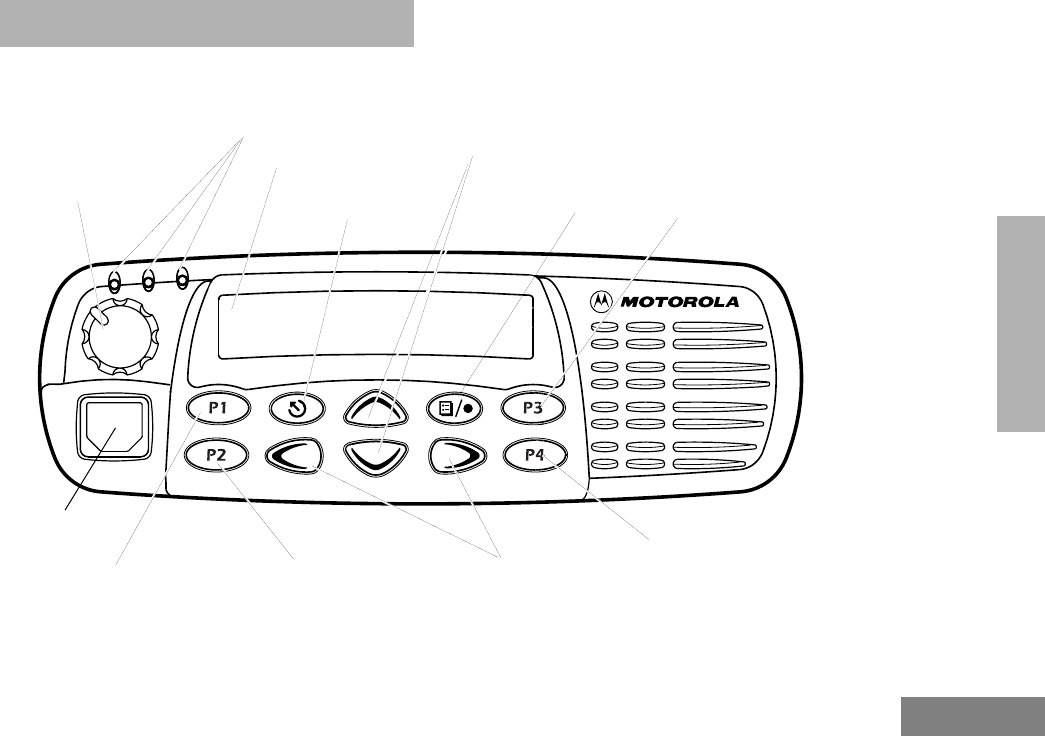
5
English
RADIO OVERVIEW
RADIO OVERVIEW
PARTS OF THE RADIO
Editing
Buttons
Menu Enter/Select
Button
(Interchangeable)
Programmable
Button 2 (P2) (Interchangeable)
Programmable
Button 4 (P4)
(Interchangeable)
Programmable
Button 3 (P3)
LCD Screen
Red/Yellow/Green
LED Indicators
Menu Exit/Escape
Button
(Interchangeable)
Programmable
Button 1 (P1) (Left/Right)
Accessory
Connector
Knob
On/Off/Volume
Channel Selector/
Menu Navigation Buttons
(Up/Down)
88C37_English.book Page 5 Wednesday, April 21, 1999 10:49 PM
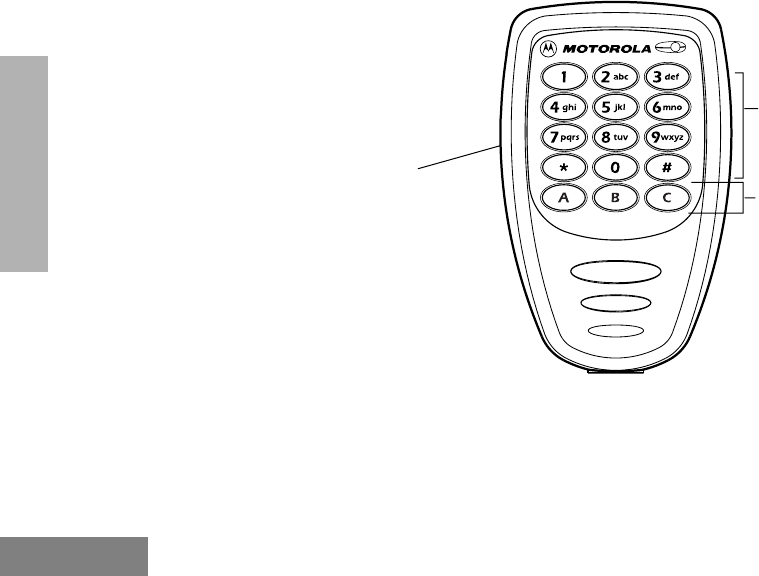
6
English
RADIO OVERVIEW
Optional Enhanced DTMF (Keypad)
Microphone (RMN4026)
Your radio may be ordered with an optional
DTMF (Dual-Tone Multi-Frequency)
microphone that has a direct entry keypad.
This keypad microphone has three buttons
(A, B, C) below the keypad that can be
programmed to conveniently activate select
radio features.
Keypad
Push-to-Talk
(PTT) button Programmable
Buttons
(A, B, C)
88C37_English.book Page 6 Wednesday, April 21, 1999 10:49 PM

7
English
RADIO OVERVIEW
On/Off/Volume Knob
Turns the radio on or off, and adjusts the
radioÕs volume.
Channel Selector/Menu Navigation Buttons
Used for channel scrolling. When in menu
mode, used for menu navigation.
LED Indicators
Indicates channel, scan, and monitor status, as
well as receipt of a selective call.
Programmable Buttons
Your radio has several programmable buttons.
Your dealer can program these buttons as
shortcuts to various radio features.
Check with your dealer for a complete list of
functions your radio supports.
Programmable buttons include the
g
,
h
,
i
, and
j
buttons (see page 5).
Some buttons can access up to two features,
depending on the type of button press:
¥
short press
Ñquickly pressing and
releasing the programmable buttons
¥
long press
Ñpressing and holding the
programmable buttons for a period of time
(at least 1 1/2 seconds)
¥
hold down
Ñpressing and holding down
the programmable buttons while checking
status or making adjustments
A summary of programmable radio features
and corresponding page references appears
beginning on page 8.
In the ÒButtonÓ column, have your dealer record
the name of the programmable button next to
the feature that has been programmed to it.
The dealer can use the abbreviations (P1, P2,
P3, P4) shown in the radio illustration on
page 5.
Also, where appropriate, have your dealer
indicate whether the button press requires a
short press, a long press, or needs to be held
down.
y or z
88C37_English.book Page 7 Wednesday, April 21, 1999 10:49 PM
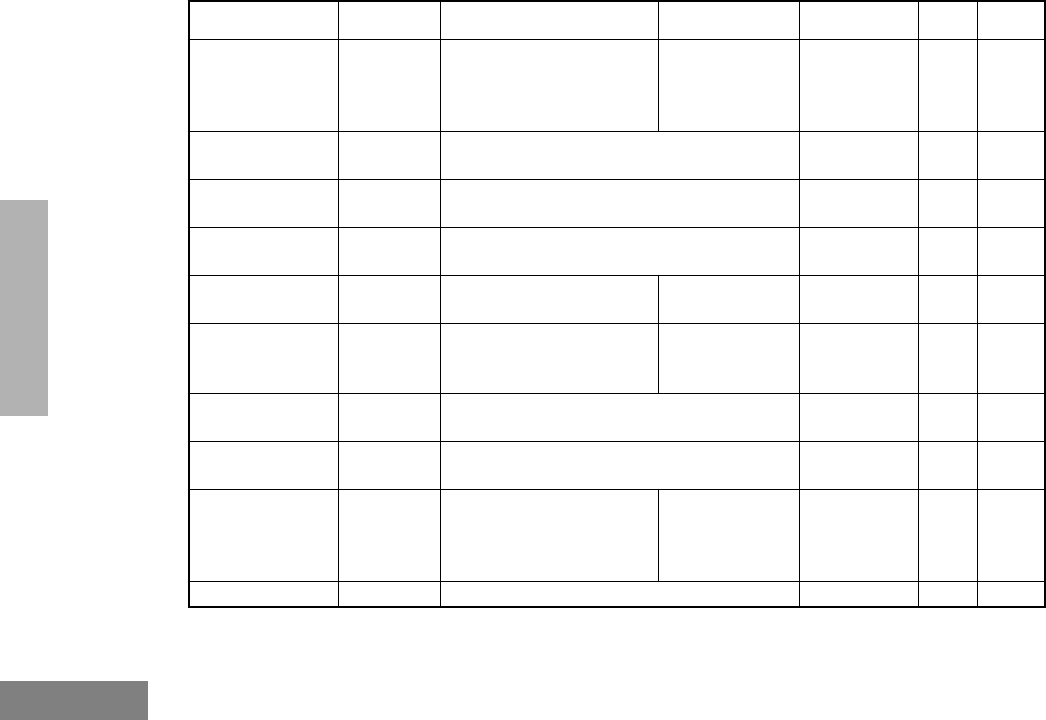
8
English
RADIO OVERVIEW
Function Indicator Short Press Long Press Hold Down Page Button
Volume Set Ñ Ñ Ñ
Sound a tone
for adjusting
your radioÕs
volume level.
15
Home Revert Ñ Takes you directly to a pre-programmed
zone/channel combination.
Ñ16
Direct Channel
Access ÑToggle the direct access channel feature.
(DTMF microphone required.) Ñ16
Direct Zone
Access ÑDirect entry to zone selection menu.
(DTMF microphone required). Ñ16
PRTT (Priority
Request- to-Talk) ÑSends a priority access
request to the dispatcher. Ñ17
Emergency
E
Initiate Emergency Alert.
Cancel
Emergency
status.
Ñ23
Power Level
B
Toggle transmit power level between High
and Low.
Ñ25
Repeater/
Talkaround
J
Toggle between using a repeater or
transmitting directly to another radio.
Ñ25
Scan/Nuisance
Channel Delete
G
Toggle scan on and off.
Delete a
nuisance
channel while
scanning.
Ñ 29-30
Phone
D
Access Phone Mode.
Ñ35
This function is activated by
EITHER
a short
OR
a long press, but not both.
88C37_English.book Page 8 Wednesday, April 21, 1999 10:49 PM
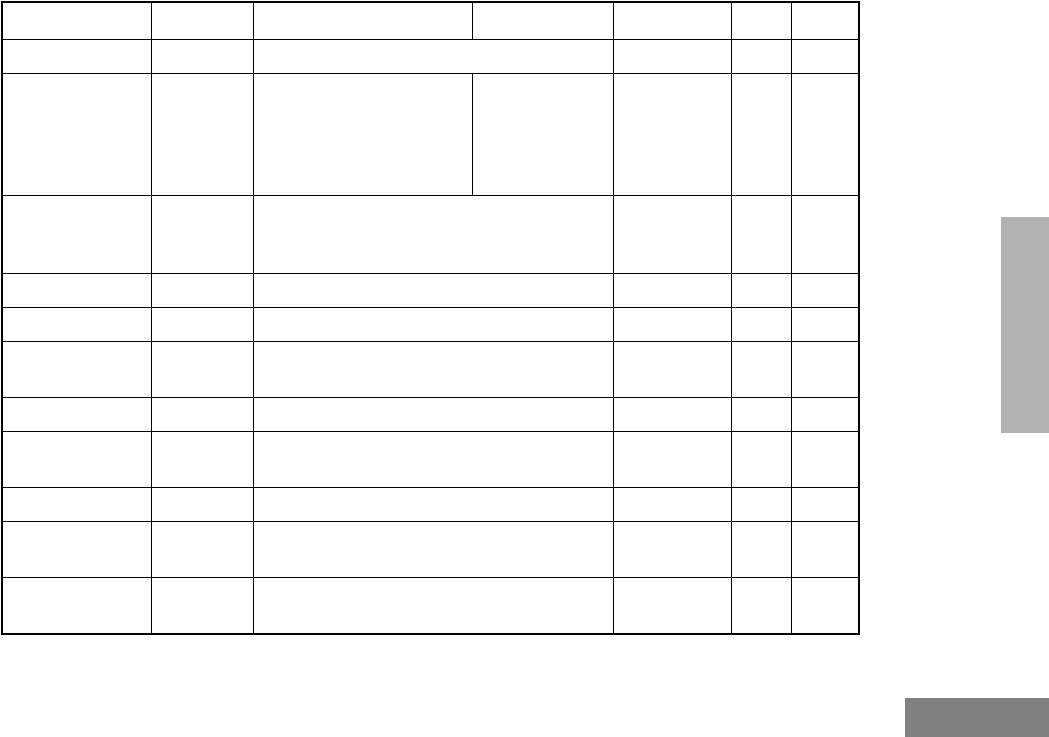
9
English
RADIO OVERVIEW
Speed Dial Ñ Access your phone list directly.
Ñ35
Monitor
C
Toggle silent monitor
operation (also turn off
open squelch monitor
when it has been
activated).
Turn on open
squelch
monitor.
ÑÑ
Option Board
(if one is
installed)
N
Toggle between activating and deactivating
the option board.
ÑÑ
Radio Call Ñ Access the radio call menu.
ÑÑ
Light Ñ Adjust brightness level (off/low/med/high).
ÑÑ
Auxiliary
Control (1/2) ÑActivates or deactivates a pin on the
accessory connector.
(See your dealer.) ÑÑ
Status Ñ Direct entry to the status menu.
ÑÑ
One-Touch
Status ÑImmediately sends a preprogrammed
status.
ÑÑ
Message Ñ Direct entry to the message menu.
ÑÑ
One-Touch
Message ÑImmediately sends a preprogrammed
message.
ÑÑ
Horn and Lights Ñ Toggles external alarm feature or cancels a
triggered alarm.
ÑÑ
This function is activated by
EITHER
a short
OR
a long press, but not both.
Function Indicator Short Press Long Press Hold Down Page Button
88C37_English.book Page 9 Wednesday, April 21, 1999 10:49 PM

10
English
RADIO OVERVIEW
Push-to-Talk (PTT) Button
Press and hold down this button to talk;
release it to listen.
Microphone
Hold the microphone 1 to 2 inches (2.5 to 5
cm) from your mouth, and speak clearly into it.
Menu Keys
Menu/Select Key
u
Used to enter Menu Mode. When in Menu
Mode, this key is also used to make menu
selections.
Exit Key
t
Used to move to the previous Menu level (short
press) or to exit Menu Mode (long press).
Up Key
y
and
Down Key
z
Used for channel scrolling. When in Menu
Mode, used for menu navigation.
Right Key
w
Moves the cursor right or inserts a space when
editing.
Left Key
v
Moves the cursor left or used as a backspace
key when editing.
Left
Up
Down Right
Menu/
Select
Exit
tyu
vzw
88C37_English.book Page 10 Wednesday, April 21, 1999 10:49 PM

11
English
RADIO OVERVIEW
Use with Optional Enhanced DTMF
Microphone (RMN4026
)
These keys are used to:
¥ Dial a phone number
¥ Make a radio call
¥ Enter information when programming radio
lists
¥ Directly access preprogrammed features
Each key can generate several different
characters. For example, to enter the character
ÒC,Ó press the
2
key three times. (Refer to the
following table.)
123
456
789
*0#
***
ABC
88C37_English.book Page 11 Wednesday, April 21, 1999 10:49 PM
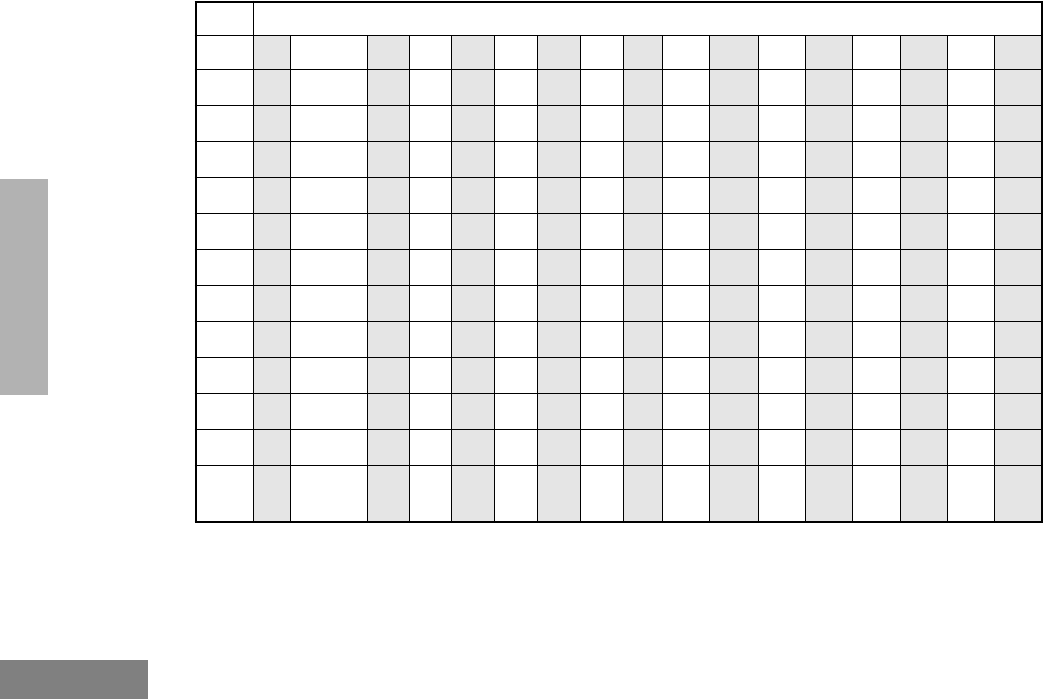
12
English
RADIO OVERVIEW
Entering Characters Using the Keypad
Number of Times Key is Pressed
Key 12 34567891011 12 13 14 15 16 17
0
0( )<>
1
1&%# *
2
ABC2abc2Ëç 傈‡‰•
3
DE F3de f3éƒ æ•Ž•‘
4
GH I4gh i4íê “’”•
5
JKL5 jkl5
6
MN O6mno6„ñ îï–˜—™š
7
PQRS7pqrs7
8
TUV8 tuv8ôò ó•œ
9
WX YZ9wxyz9 Y y
*
*/+-=
#
#
Blank
Space -.!?ÕÓ,; :
88C37_English.book Page 12 Wednesday, April 21, 1999 10:49 PM
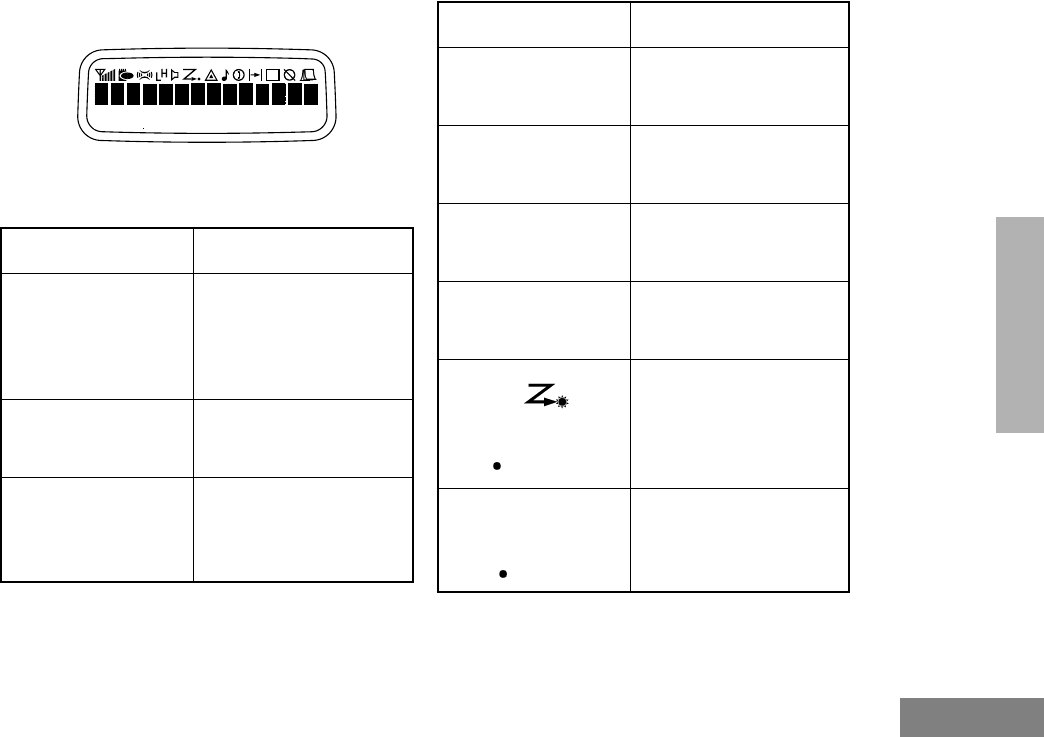
13
English
RADIO OVERVIEW
LCD Screen
The top screen row displays radio status
information:
Symbol Indication
A
Companding
The Companding
feature is activated.
When in narrow band,
this feature improves
audio quality.
B
Power Level
Low Power Ò R Ò or High
Power Ò S Ò is activated.
C
Carrier Squelch
(CSQ)
The radio is on a CSQ
channel, monitor is
active, or the
microphone is off-hook.
D
Phone
Phone Mode is
selected.
E
Emergency
An Emergency Alert is
being sent.
F
Call Received
A Selective Call or Call
Alert has been received.
G
Scan
The Scan feature is
active.
Priority 1 Scan
( ßashing)
During Scan, indicates
that the scan has locked
on to a priority 1
channel.
H
Priority 2 Scan
( steady)
During Scan, indicates
that the scan has locked
on to a priority 2
channel.
Symbol Indication
88C37_English.book Page 13 Wednesday, April 21, 1999 10:49 PM
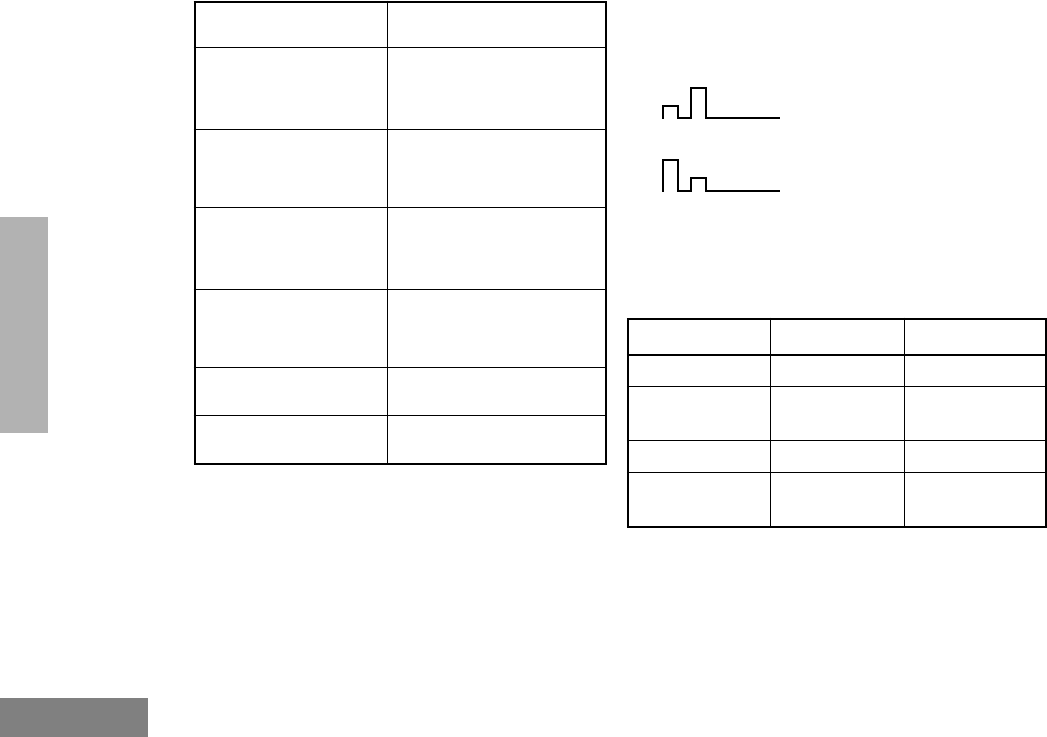
14
English
RADIO OVERVIEW
AUDIO INDICATORS FOR
PROGRAMMABLE BUTTONS
In addition to having associated visual
indicators, some programmable buttons use
tones to indicate one of two modes:
J
Talkaround
The radio is not
transmitting through a
repeater.
K
Programming Mode
The radio is in Program
List editing mode.
M
Signal Strength
Indicates signal
strength. The more bars,
the stronger the signal.
N
Option Board
Option board is enabled.
QNot currently assigned.
LNot currently assigned.
Symbol Indication
Low-High Tone
High-Low Tone
Button Low-High Tone High-Low Tone
Scan Start scan Stop scan
Power Level High power
selected
Low power
selected
Option Board Enabled Disabled
Repeater/
Talkaround
Does not use
repeater
Uses repeater
88C37_English.book Page 14 Wednesday, April 21, 1999 10:49 PM
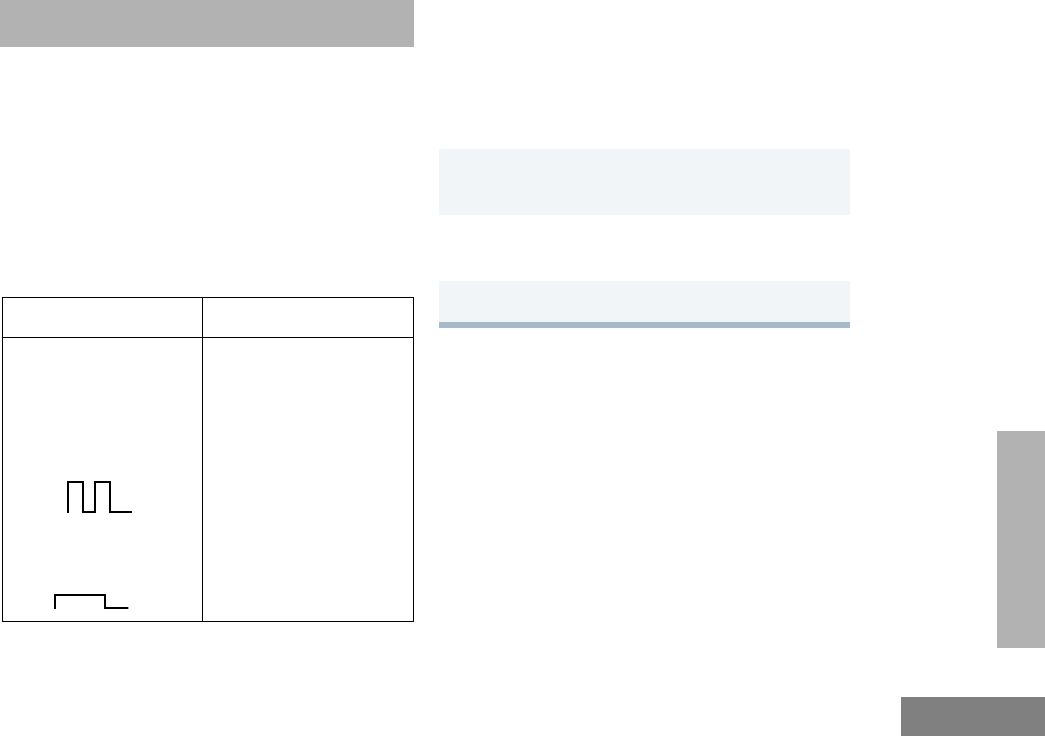
15
English
GETTING STARTED
GETTING STARTED
TURNING THE RADIO ON OR OFF
ADJUSTING THE VOLUME
Turn the On/Off/Volume Control knob
clockwise to increase the volume, or
counterclockwise to decrease the volume.
ÐorÐ
ON OFF
Push the On/Off/
Volume Control knob
until you hear a click.
If power-up is
successful, you will
hear the Self-Test Pass
Tone.
If the radio fails to
power up, you will hear
the Self-Test Fail
Tone .
Push the On/Off/
Volume Control knob
until you hear a click and
the display clears.
1Hold down the Volume Set button (see
page 8). You will hear a continuous tone.
2Turn the On/Off/Volume Control knob to the
desired volume level.
3Release the Volume Set button.
88C37_English.book Page 15 Wednesday, April 21, 1999 10:49 PM
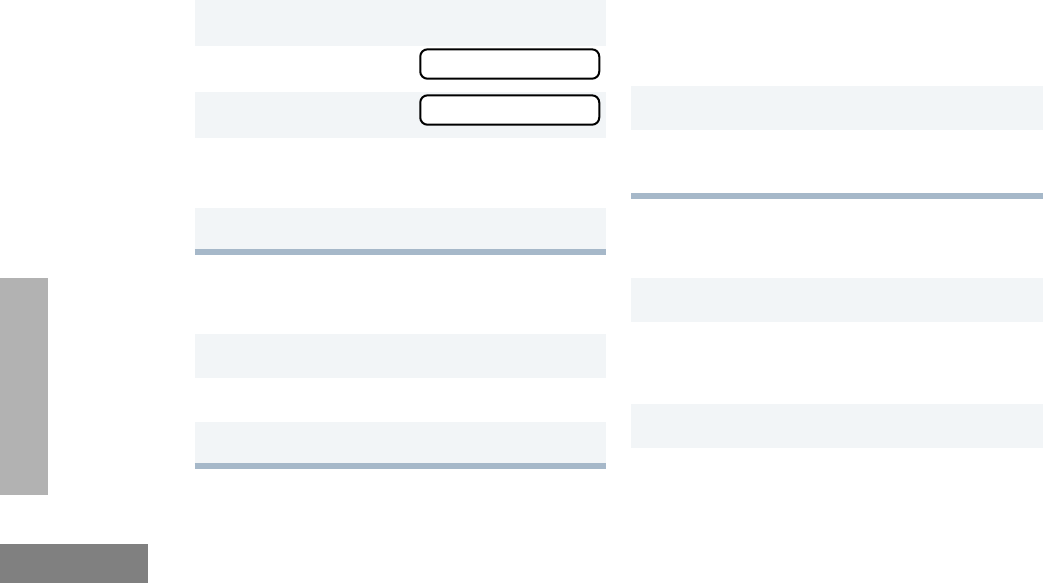
16
English
GETTING STARTED
SELECTING A ZONE
A zone is a group of up to 16 channels. Before
you can access a channel in a zone, you must
select the zone in one of two ways:
Method 1
Method 2 (if programmed by your dealer [see
pages 8 -9]).
SELECTING A RADIO CHANNEL
Your radio offers 128 channels (8 zones of 16
channels each).
Note: Due to government regulations, some
channels may not be programmed.
See your dealer for more information.
There are three ways to select a channel:
Method 1
Method 2 (if programmed by your dealer [see
pages 8 -9]).
Method 3 (if programmed by your dealer [see
pages 8 -9]).
1u to enter Menu Mode.
2y or z until
3u to select
4y or z until you see the desired zone
name.
5u to select the zone.
1Press the Direct Zone Access button.
2y or z until you reach the desired zone.
3u to select the zone.
ZZ
ZZoo
oonn
nnee
ee
ZZ
ZZoo
oonn
nnee
ee 1Select the appropriate Zone, if required.
2y or z until you reach the desired
channel, shown on LCD display.
1Press the Home Revert button.
1Press the Direct Channel Access button.
88C37_English.book Page 16 Wednesday, April 21, 1999 10:49 PM
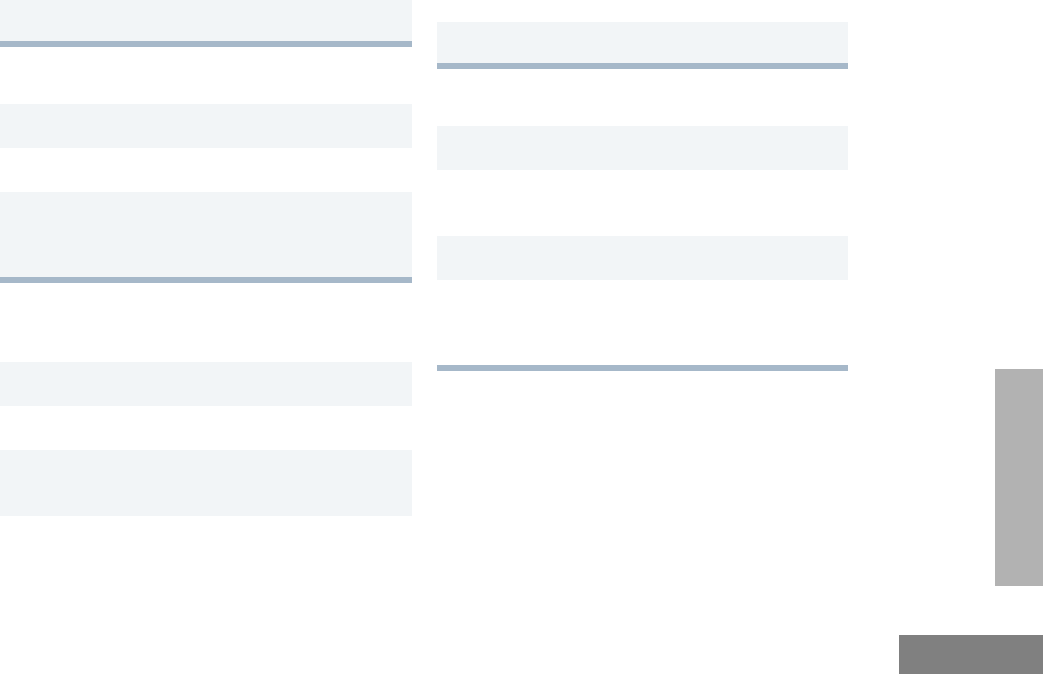
17
English
GETTING STARTED
SENDING A CALL
If your system uses the request-to-talk feature,
use the following method to send a call:
RECEIVING A CALL
2Enter the desired channel using the DTMF
keypad microphone.
3u to conÞrm your selection.
1Turn your radio on.
2y or z to select the desired channel.
3Hold the microphone vertically 1 to 2 inches
(2.5 to 5 cm) from your mouth. Press the PTT
to talk; release it to listen.
1Turn your radio on.
2y or z to select the desired channel.
3Press the PTT (for priority requests to talk, the
PRTT button) and wait for the talk permit tone.
4Hold the microphone vertically 1 to 2 inches
(2.5 to 5 cm) from your mouth. Press the PTT
to talk; release it to listen.
5Release the PTT to listen.
1Turn your radio on.
2Adjust the radioÕs volume, if necessary (see
page 15).
3Select the desired channel.
4Hold the microphone vertically 1 to 2 inches
(2.5 to 5 cm) from your mouth. Press the PTT
to talk; release it to listen.
88C37_English.book Page 17 Wednesday, April 21, 1999 10:49 PM

18
English
GETTING STARTED
Notes
88C37_English.book Page 18 Wednesday, April 21, 1999 10:49 PM
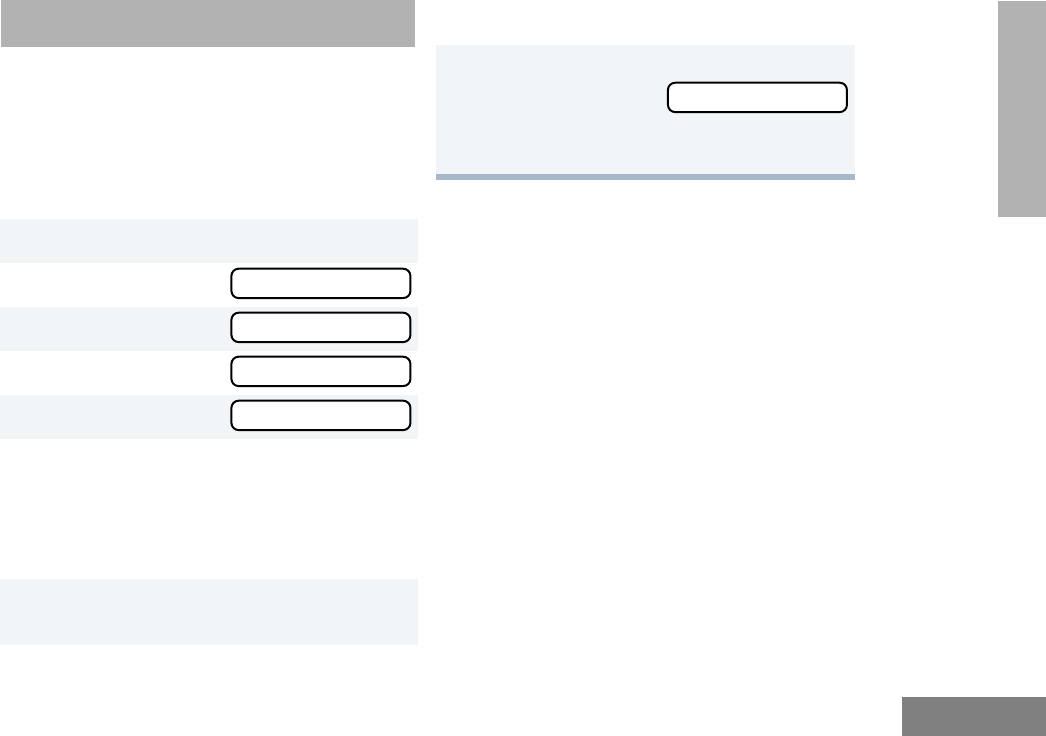
19
English
RADIO CALLS
RADIO CALLS
MAKING A SELECTIVE CALL
You can make a selective call to a particular radio
or group of radios, provided the signalling
protocol supports it.
To make a Selective Call: RECEIVING A SELECTIVE CALL F
When you receive a selective call:
¥ You will hear two alert tones.
¥ The LED Indicator ßashes yellow.
¥ The LCD screen displays F and the
preprogrammed name or ID of the calling
radio, if available.
1u to enter Menu Mode.
2y or z until
3u to select
4y or z until
5u to select
6y or z to locate the desired ID in the
Radio Call List.
ÐorÐ
when using the keypad microphone only, enter
the ID number of the radio you want to call.
7Press the PTT to send the call. The radio
sounds a continuous tone.
RR
RRaa
aadd
ddii
iioo
oo
CC
CCaa
aall
llll
ll
RR
RRaa
aadd
ddii
iioo
oo
CC
CCaa
aall
llll
ll
SS
SSee
eell
llee
eecc
cctt
ttii
iivv
vvee
ee
CC
CCaa
aall
llll
ll
SS
SSee
eell
llee
eecc
cctt
ttii
iivv
vvee
ee
CC
CCaa
aall
llll
ll
8Press the PTT to talk; release it to listen.
9When Þnished with the call,
t to return to
ÐorÐ
Hold down t to exit Menu Mode.
SS
SSee
eell
llee
eecc
cctt
ttii
iivv
vvee
ee
CC
CCaa
aall
llll
ll
88C37_English.book Page 19 Wednesday, April 21, 1999 10:49 PM
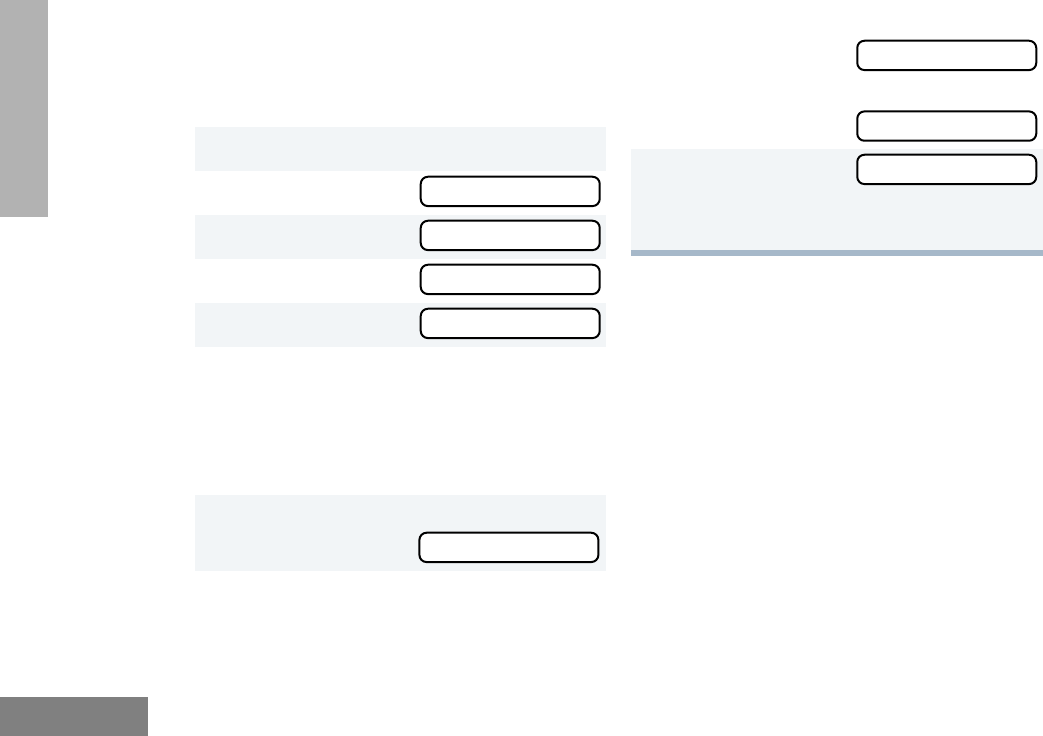
20
English
RADIO CALLS
SENDING A CALL ALERTª PAGE
You can alert another person by sending a Call
Alert page.
To send a Call Alert page:
RECEIVING A CALL ALERT PAGE
When your radio receives a Call Alert page, it
sounds four alert tones continuously and the
following are displayed until you respond:
the F symbol, and the ID of the calling radio
alternating with Call Received.
Press the PTT to answer the page, or press
any other key to clear it.
Note: Your radio will display only the last Call
Alert page received. Also, your radio
will not receive any Selective Calls until
you clear the page.
1u to enter Menu Mode.
2y or z until
3u to select
4y or z until
5) to select
6y or z to locate the desired ID in the
Radio Call List;
ÐorÐ
when using the keypad microphone only, enter
the ID number of the radio you want to page.
7Press the PTT to send the page.
You will see
RR
RRaa
aadd
ddii
iioo
oo
CC
CCaa
aall
llll
ll
RR
RRaa
aadd
ddii
iioo
oo
CC
CCaa
aall
llll
ll
CC
CCaa
aall
llll
ll
AA
AAll
llee
eerr
rrtt
tt
CC
CCaa
aall
llll
ll
AA
AAll
llee
eerr
rrtt
tt
CC
CCaa
aall
llll
ll
II
IInn
nn
PP
PPrr
rroo
oogg
gg
8If the Call Alert page is received,
you will see
If not,
you will see
9t to return to
ÐorÐ
Hold down t to exit Menu Mode.
AA
AAcc
cckk
kknn
nnoo
ooww
wwll
llee
eedd
ddgg
ggee
ee
NN
NNoo
oo
AA
AAcc
cckk
kknn
nnoo
ooww
wwll
llee
eedd
ddgg
ggee
ee
CC
CCaa
aall
llll
ll
AA
AAll
llee
eerr
rrtt
tt
88C37_English.book Page 20 Wednesday, April 21, 1999 10:49 PM
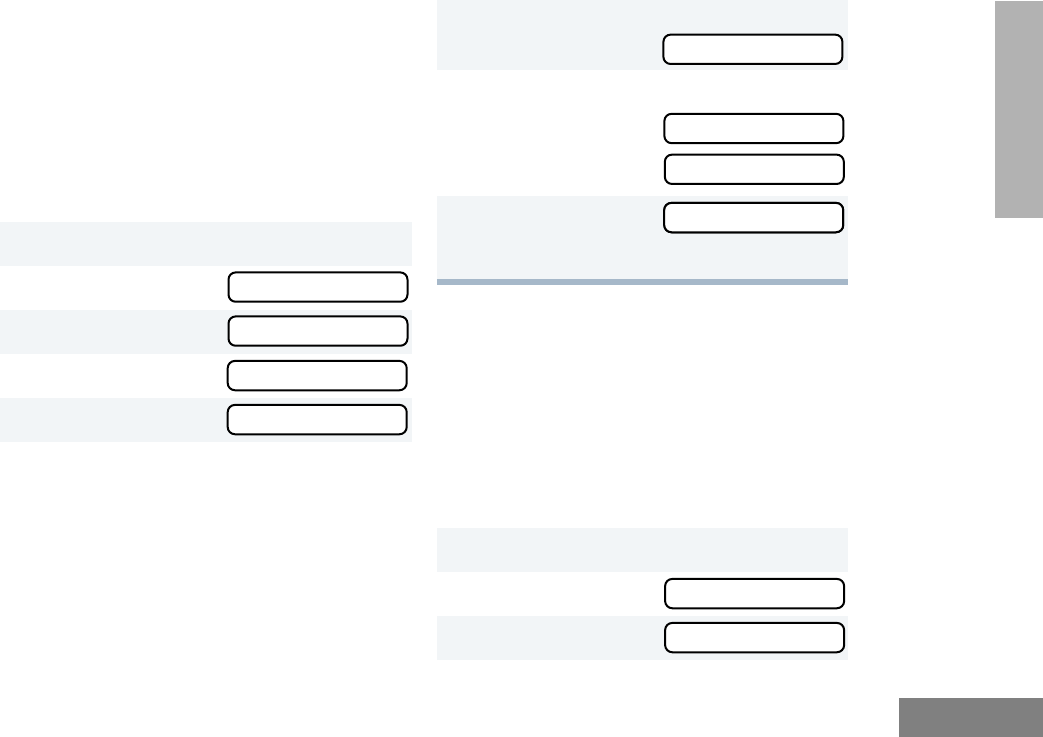
21
English
RADIO CALLS
RADIO CHECK
This feature allows you to determine if a radio
is in range without disturbing the user of the
radio. Radio Check can also be used when
attempts with Selective Call and Call Alert fail.
(This feature is available only if your signalling
protocol supports it.)
To perform a Radio Check:
SENDING A STATUS
This feature gives you the ability to send a
status update to the base. The status feature
makes more efÞcient use of the channel
compared to voice transmissions. Status
updates of up to 14 characters may be
programmed by your dealer.
To send a Status:
1u to enter Menu Mode.
2y or z until
3u to select
4y or z until
5u to select
6y or z to locate the desired ID in the
Radio Call List;
ÐorÐ
when using the keypad microphone only,
enter the ID number of the radio you are
checking.
RR
RRaa
aadd
ddii
iioo
oo
CC
CCaa
aall
llll
ll
RR
RRaa
aadd
ddii
iioo
oo
CC
CCaa
aall
llll
ll
RR
RRaa
aadd
ddii
iioo
oo
CC
CChh
hhee
eecc
cckk
kk
RR
RRaa
aadd
ddii
iioo
oo
CC
CChh
hhee
eecc
cckk
kk
7Press the PTT.
You will see
8If the Radio Check is received,
you will see
If not, you will see
9t to return to
ÐorÐ
Hold down t to exit Menu Mode.
1u to enter Menu Mode.
2y or z until
3u to select
CC
CCaa
aall
llll
ll
II
IInn
nn
PP
PPrr
rroo
oogg
gg
AA
AAcc
cckk
kknn
nnoo
ooww
wwll
llee
eedd
ddgg
ggee
ee
NN
NNoo
oo
AA
AAcc
cckk
kknn
nnoo
ooww
wwll
llee
eedd
ddgg
ggee
ee
RR
RRaa
aadd
ddii
iioo
oo
CC
CChh
hhee
eecc
cckk
kk
RR
RRaa
aadd
ddii
iioo
oo
CC
CChh
hhee
eecc
cckk
kk
SS
SStt
ttaa
aatt
ttuu
uuss
ss
SS
SStt
ttaa
aatt
ttuu
uuss
ss
88C37_English.book Page 21 Wednesday, April 21, 1999 10:49 PM

22
English
RADIO CALLS
SENDING A MESSAGE
This feature gives you the ability to send and
receive preprogrammed messages. Data
messages make more efÞcient use of channels
compared to voice transmissions. Messages of
up to 14 characters may be programmed by
your dealer.
To send an electronic (data) message:
4y or z to locate the desired status in
the pre-programmed list.
ÐorÐ when using the keypad microphone
only,
enter the number of the status you wish to
send.
ÐorÐ if programmed by your dealer (see
pages 8 -9),
press the button that has been
preprogrammed for a speciÞc status.
Note: You cannot retransmit the current
status update.
1u to enter Menu Mode.
2y or z until
3u to select
4y or z to locate the desired message in
the preprogrammed list.
ÐorÐ when using the keypad microphone
only,
enter the number of the message you wish to
send.
ÐorÐ if programmed by your dealer (see
pages 8 -9),
press the button that has been
preprogrammed for a speciÞc message.
MM
MMee
eess
ssss
ssaa
aagg
ggee
ee
MM
MMee
eess
ssss
ssaa
aagg
ggee
ee
88C37_English.book Page 22 Wednesday, April 21, 1999 10:49 PM
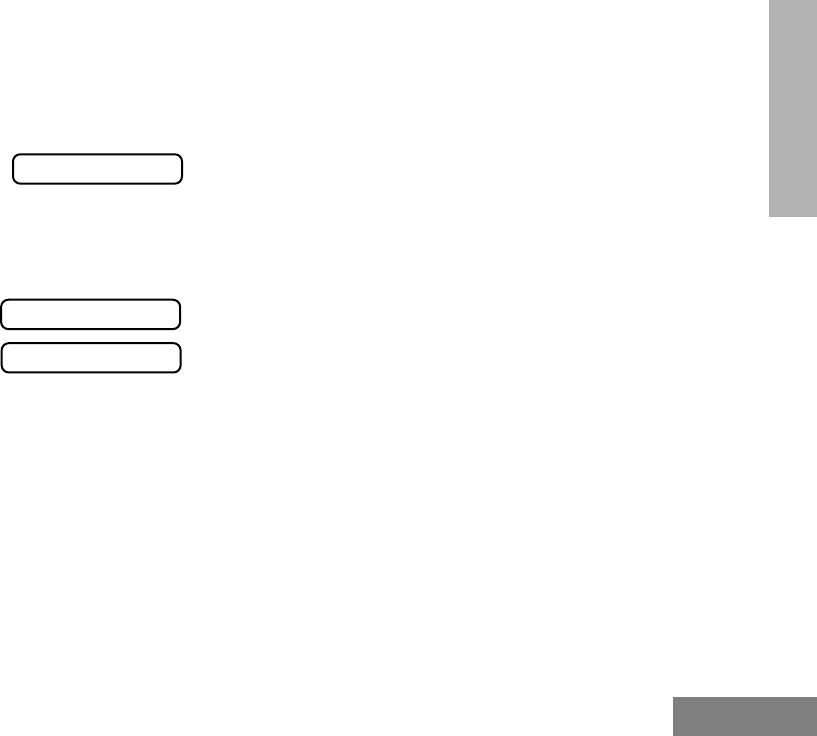
23
English
RADIO CALLS
RECEIVING A MESSAGE
When your radio receives a message:
¥ You will hear two alert tones.
¥ The LED indicator ßashes yellow.
¥ The LCD screen
displays
alternating with the preprogrammed alias.
Note: If you receive a message that is
programmed into your radio, the display
will alternate with the following:
and
SENDING AN EMERGENCY ALERT E
A priority Emergency Alert can be sent to a
speciÞc radio or dispatch center by pressing:
¥ A button preprogrammed by your dealer
(see pages 8 -9).
¥ The footswitch
¥ A pushbutton accessory
Emergency Alerts have priority over all other
calls.
The E symbol will appear on the display when
your radio is in the Emergency Alert state.
An Emergency Alert can be programmed to:
¥ Show E and sound a tone
ÐorÐ
¥ Show E (Silent Emergency)
ÐorÐ
¥ Activate the microphone so that all activity
can be transmitted (for a predetermined
amount of time). See your dealer for more
information.
To cancel the Emergency Alert, press and hold
down the Emergency button.
MM
MMss
ssgg
gg
RR
RRee
eecc
ccee
eeii
iivv
vvee
eedd
dd
MM
MMee
eess
ssss
ssaa
aagg
ggee
ee
##
##__
__
NN
NNoo
oo
AA
AAll
llii
iiaa
aass
ss
88C37_English.book Page 23 Wednesday, April 21, 1999 10:49 PM
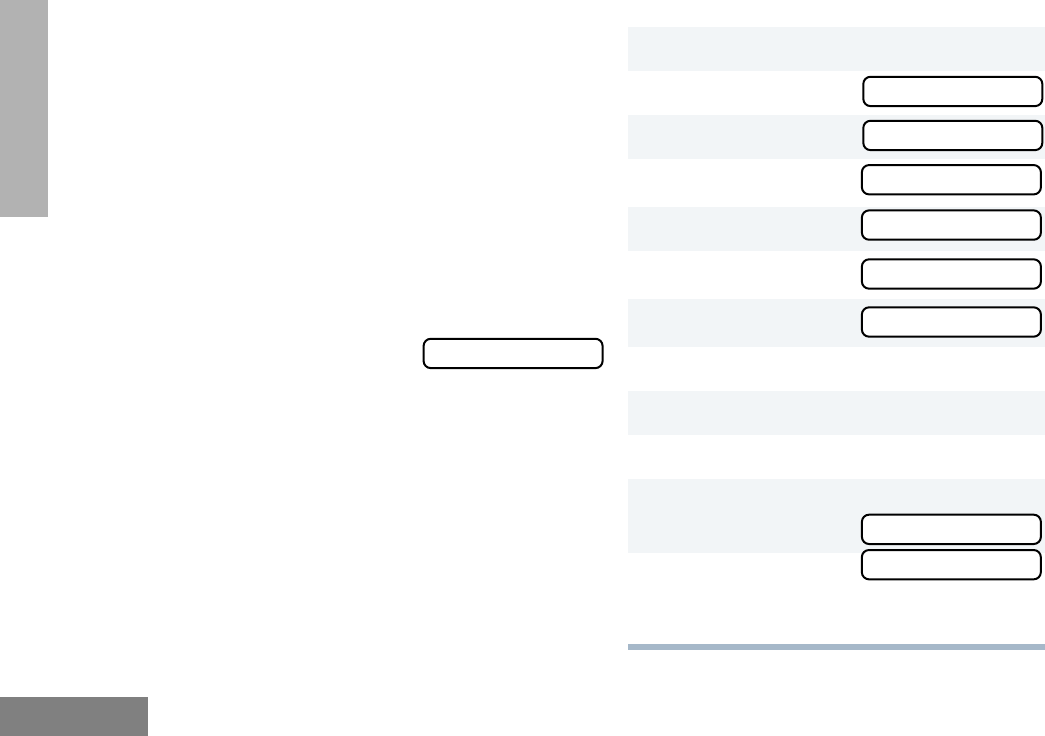
24
English
RADIO CALLS
RECEIVING SELECTIVE RADIO
INHIBIT
Your radio is equipped with a security feature
that can temporarily render the unit
inoperative.
This feature is commonly used to disable radios:
¥ In case of theft
¥ When your vehicle is being serviced
¥ For system control reasons
Note: When your radio has been disabled, all
controls will be inoperative. When the
radio is powered up, the display will
show:
EDITING A RADIO CALL LIST K
The ID numbers in your Radio Call List are
preprogrammed by your dealer. However, you
can edit the names associated with these IDs
using the optional keypad microphone. The
K symbol will appear on the display when
you are editing.
Note: Your radio cannot receive any calls
while you are editing.
To edit a Call List entry:
RR
RRaa
aadd
ddii
iioo
oo
DD
DDii
iiss
ssaa
aabb
bbll
llee
eedd
dd
1u to enter Menu Mode.
2y or z until
3u to select
4y or z until
5u to select
6y or z until
7u to select
8y or z until you locate the desired entry.
9u to select the entry.
10 Use your keypad to edit the entry (see page 11).
11 u to save your changes.
You will see
12 t to return to
ÐorÐ
Hold down t to exit Menu Mode.
PP
PPrr
rroo
oogg
ggrr
rraa
aamm
mm
LL
LLii
iiss
sstt
ttss
ss
PP
PPrr
rroo
oogg
ggrr
rraa
aamm
mm
LL
LLii
iiss
sstt
ttss
ss
RR
RRaa
aadd
ddii
iioo
ooCC
CCaa
aall
llll
ll
LL
LLii
iiss
sstt
tt
RR
RRaa
aadd
ddii
iioo
ooCC
CCaa
aall
llll
ll
LL
LLii
iiss
sstt
tt
EE
EEdd
ddii
iitt
tt
EE
EEnn
nntt
ttrr
rryy
yy??
??
EE
EEdd
ddii
iitt
tt
EE
EEnn
nntt
ttrr
rryy
yy??
??
EE
EEnn
nntt
ttrr
rryy
yy
SS
SSaa
aavv
vvee
eedd
dd
EE
EEdd
ddii
iitt
tt
EE
EEnn
nntt
ttrr
rryy
yy??
??
88C37_English.book Page 24 Wednesday, April 21, 1999 10:49 PM
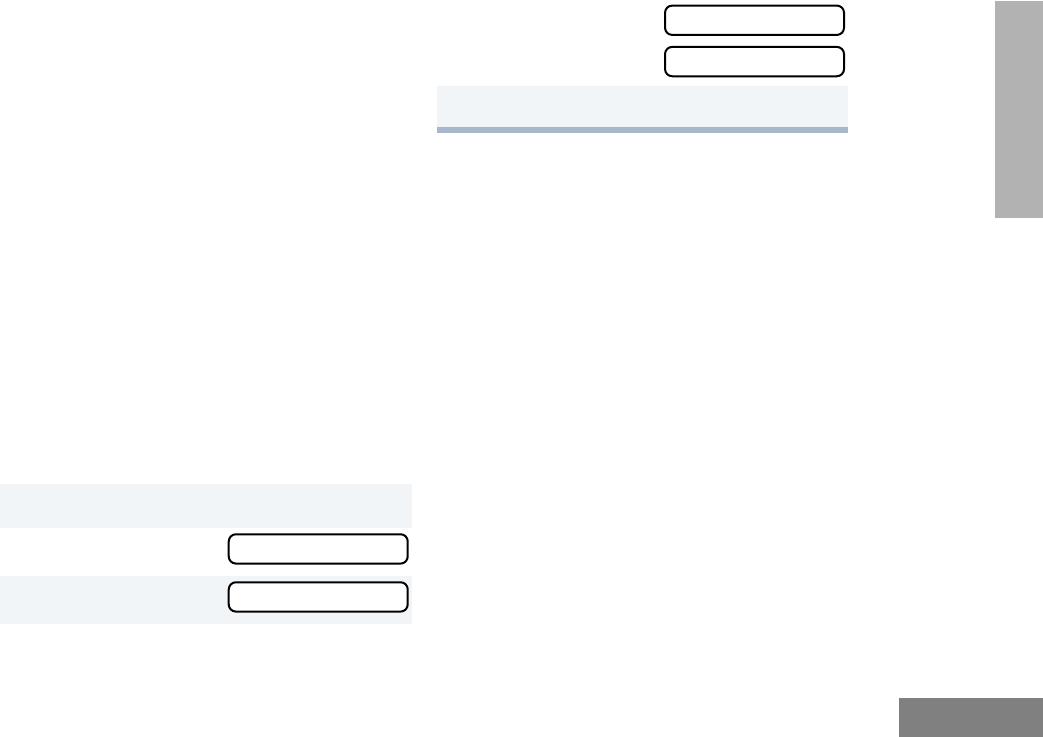
25
English
RADIO CALLS
REPEATER OR TALKAROUND J
MODE
Talkaround Mode enables you to communicate
with another radio when either:
¥ The repeater is not operating.
ÐorÐ
¥ Your radio is out of the repeaterÕs range but
within communicating distance of another
radio. The J symbol appears on the
display when Talkaround Mode is selected.
To select either Repeater Mode or Talkaround
Mode:
Press the preprogrammed Repeater/
Talkaround button (see page 8) to toggle
between Repeater Mode and Talkaround
Mode.
ÐorÐ
SETTING THE POWER LEVEL B
Each channel in your radio has a predeÞned
transmit power level that can be changed.
¥ High power ( S )
¥ Low power ( R )
¥ Auto power automatically sets the optimal
power level based on the strength of the
signal received. If the received signal is
weak, the transmit level will be set to high,
and if strong, will be set to low.
Note: A message received from a nearby
radio might change your radioÕs
power level to low, causing radios
that are farther away not to receive
your transmissions.
1u to enter Menu Mode.
2y or z until
3u to select
RR
RRpp
pptt
ttrr
rr//
//TT
TTaa
aall
llkk
kkaa
aarr
rrnn
nndd
dd
RR
RRpp
pptt
ttrr
rr//
//TT
TTaa
aall
llkk
kkaa
aarr
rrnn
nndd
dd
4y or z until
or until
5u to conÞrm your selection.
RR
RRee
eepp
ppee
eeaa
aatt
ttee
eerr
rr
MM
MMoo
oodd
ddee
ee
TT
TTaa
aall
llkk
kkaa
aarr
rrnn
nndd
dd
MM
MMoo
oodd
ddee
ee
88C37_English.book Page 25 Wednesday, April 21, 1999 10:49 PM
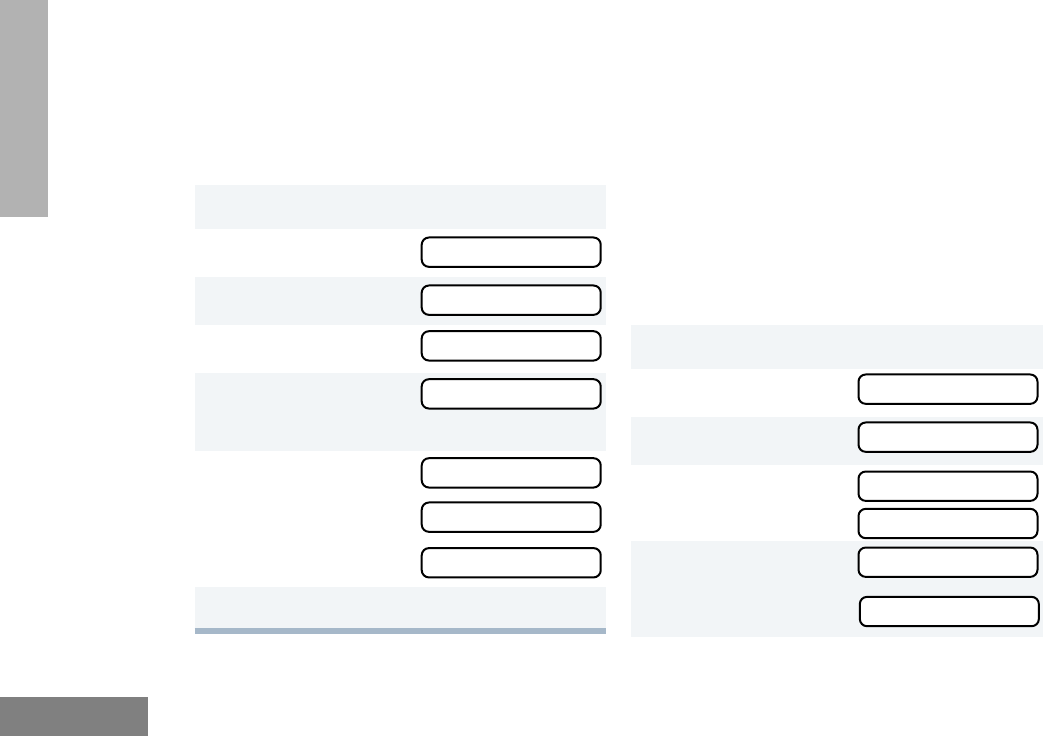
26
English
RADIO CALLS
You can set the power level in two ways:
Method 1
Press the preprogrammed Power Level button
(see page 8) to toggle between low and high.
ÐorÐ
Method 2
NAME AND CALL/MESSAGE TONE
TAGGING
You can program your radio to sound a
particular alert tone when:
¥ a speciÞc user is callingÑname tone
tagging, or
¥ a message is being sent to your radio, or
¥ your radio is receiving a type of radio callÑ
call tone tagging.
There are seven alert tones to select from.
To tag a speciÞc userÕs name or message:
1u to enter Menu Mode.
2y or z until
3u to select
4y or z until
5u to select
The display shows the current power level.
6y or z until
or until
or until
7u to conÞrm the selection.
UU
UUtt
ttii
iill
llii
iitt
ttii
iiee
eess
ss
UU
UUtt
ttii
iill
llii
iitt
ttii
iiee
eess
ss
PP
PPoo
ooww
wwee
eerr
rr
LL
LLee
eevv
vvee
eell
ll
PP
PPoo
ooww
wwee
eerr
rr
LL
LLee
eevv
vvee
eell
ll
PP
PPoo
ooww
wwee
eerr
rr
HH
HHii
iigg
gghh
hh??
??
PP
PPoo
ooww
wwee
eerr
rr
LL
LLoo
ooww
ww??
??
PP
PPoo
ooww
wwee
eerr
rr
AA
AAuu
uutt
ttoo
oo??
??
1u to enter Menu Mode.
2y or z until
3u to select
4y or z until
or
5u to select
or
AA
AAuu
uudd
ddii
iioo
oo//
//TT
TToo
oonn
nnee
eess
ss
AA
AAuu
uudd
ddii
iioo
oo//
//TT
TToo
oonn
nnee
eess
ss
NN
NNaa
aamm
mmee
ee
TT
TToo
oonn
nnee
ee
TT
TTaa
aagg
gg
MM
MMss
ssgg
gg
TT
TToo
oonn
nnee
ee
TT
TTaa
aagg
gg
NN
NNaa
aamm
mmee
ee
TT
TToo
oonn
nnee
ee
TT
TTaa
aagg
gg
MM
MMss
ssgg
gg
TT
TToo
oonn
nnee
ee
TT
TTaa
aagg
gg
88C37_English.book Page 26 Wednesday, April 21, 1999 10:49 PM
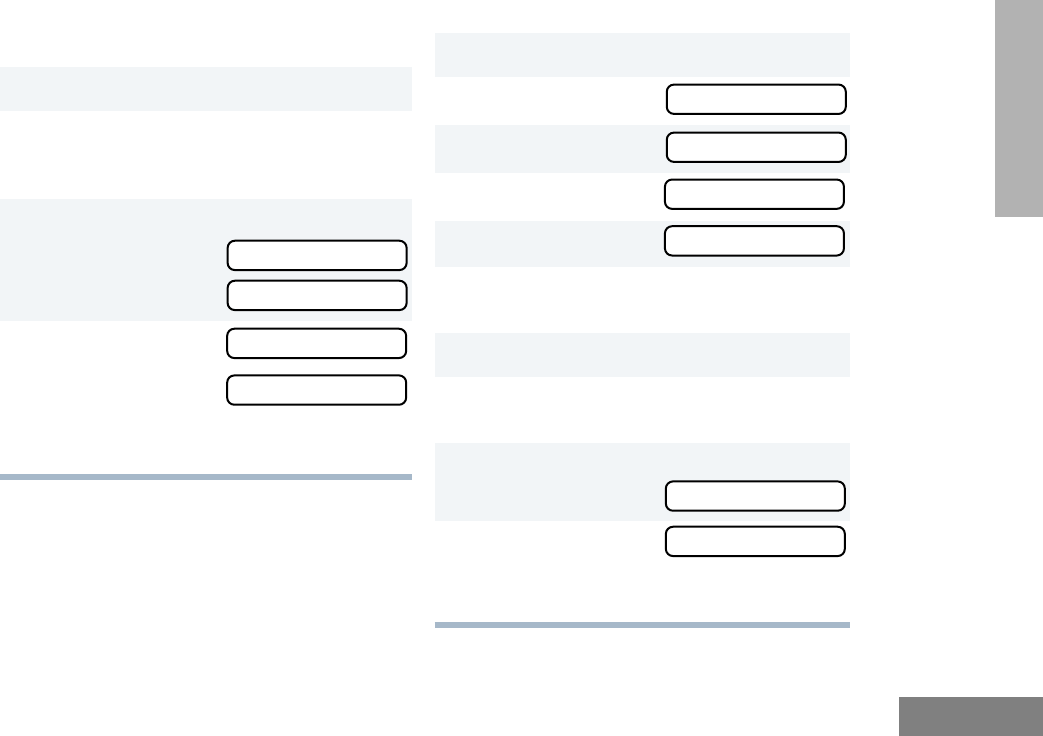
27
English
RADIO CALLS
To tag a type of radio call or message:
6y or z until you see the name or
message you want to tag.
7u to conÞrm the selection.
8y or z until you hear one of the seven
tones you want to use for this name or
message.
9u to conÞrm the selection.
You will see
or
10 t to return to
or
ÐorÐ
Hold down t to exit Menu Mode.
MM
MMss
ssgg
gg
TT
TToo
oonn
nnee
ee
TT
TTaa
aagg
gg
NN
NNaa
aamm
mmee
ee
TT
TTaa
aagg
gg
SS
SSee
eett
tt
MM
MMss
ssgg
gg
TT
TToo
oonn
nnee
ee
TT
TTaa
aagg
gg
NN
NNaa
aamm
mmee
ee
TT
TToo
oonn
nnee
ee
TT
TTaa
aagg
gg
1u to enter Menu Mode.
2y or z until
3u to select
4y or z until
5u to select
6y or z until you see the call type you
want to tag.
7u to conÞrm the selection.
8y or z until you hear the tone you want
to use for this type of call.
9u to conÞrm the selection.
You will see
10 t to return to
ÐorÐ
Hold down t to exit Menu Mode.
AA
AAuu
uudd
ddii
iioo
oo//
//TT
TToo
oonn
nnee
eess
ss
AA
AAuu
uudd
ddii
iioo
oo//
//TT
TToo
oonn
nnee
eess
ss
CC
CCaa
aall
llll
ll
TT
TToo
oonn
nnee
ee
TT
TTaa
aagg
gg
CC
CCaa
aall
llll
ll
TT
TToo
oonn
nnee
ee
TT
TTaa
aagg
gg
CC
CCaa
aall
llll
ll
TT
TToo
oonn
nnee
ee
TT
TTaa
aagg
gg
CC
CCaa
aall
llll
ll
TT
TToo
oonn
nnee
ee
TT
TTaa
aagg
gg
88C37_English.book Page 27 Wednesday, April 21, 1999 10:49 PM

28
English
RADIO CALLS
Notes
88C37_English.book Page 28 Wednesday, April 21, 1999 10:49 PM
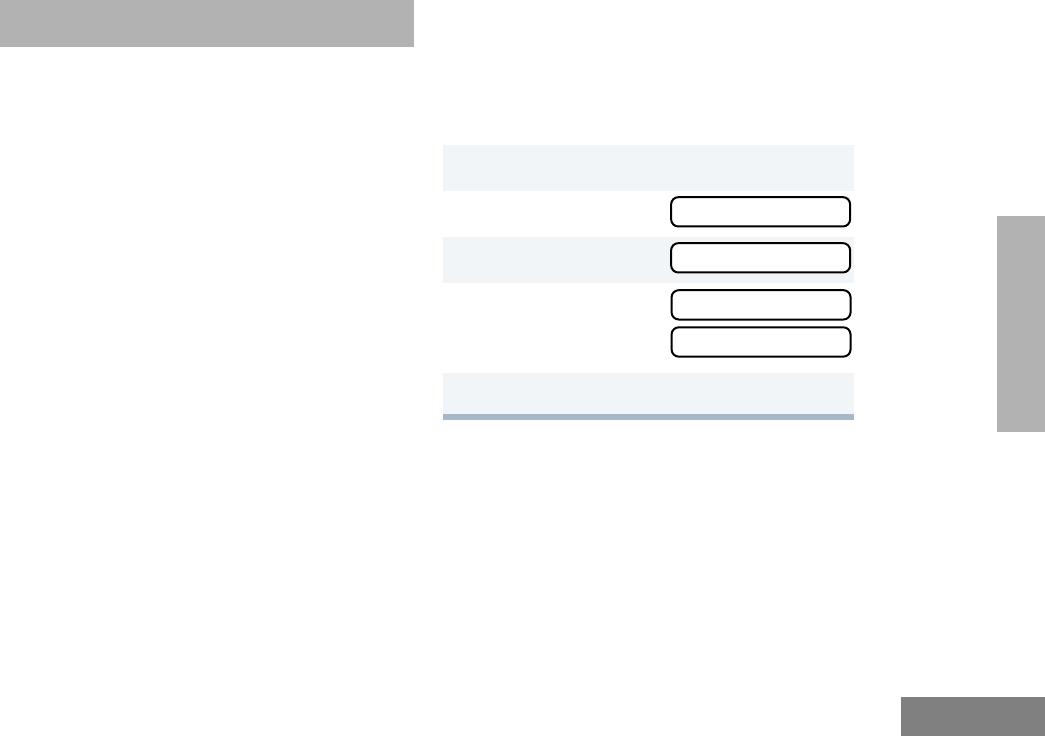
29
English
SCAN
SCAN
Your radio can monitor multiple channels in a
scan list. Your dealer can program up to 16
different channels into each scan list. When
your radio detects activity on a scan list
channel, it will automatically switch to that
channel.
Note: The same channels can be assigned to
different scan lists.
STARTING OR STOPPING SCAN G
The Gsymbol, and the number of the
channel you are transmitting on, will appear on
the display when you start a scan operation.
The green LED indicator blinks during a scan
operation and stops blinking when the radio
switches to a channel.
Note: If you enter Menu Mode while the radio
is scanning, scanning will stop. It will
resume when you exit Menu Mode.
You can start or stop a scan operation either
by:
pressing the preprogrammed Scan button (see
page 8) to start or stop scanning;
ÐorÐ
1) to enter Menu Mode.
2+ or e until
3) to select
4+ or e until
ÐorÐ
5) to conÞrm your selection.
SS
SSyy
yyss
sstt
ttee
eemm
mm
SS
SScc
ccaa
aann
nn
SS
SSyy
yyss
sstt
ttee
eemm
mm
SS
SScc
ccaa
aann
nn
SS
SSyy
yyss
ss
SS
SScc
ccaa
aann
nn
OO
OOnn
nn??
??
SS
SSyy
yyss
ss
SS
SScc
ccaa
aann
nn
OO
OOff
ffff
ff??
??
88C37_English.book Page 29 Wednesday, April 21, 1999 10:49 PM

30
English
SCAN
TALKBACK
The Talkback feature allows you to respond to a
transmission while scanning. If a transmission on
a channel is detected while scanning, the radio
will stop on that channel for a preprogrammed
period of time. During this ÒhangtimeÓ you may
respond by pressing the PTT.
Note: If transmission stops/ceases or if the PTT
is not pressed for a preprogrammed
duration, the radio will continue scanning.
Also, the LED scan indicator stops
blinking while the radio is in hangtime.
DELETING A NUISANCE CHANNEL
If a channel continually generates unwanted calls
or noise (a ÒnuisanceÓ channel), use the Scan
button to temporarily delete the channel from the
scan list.
Note:You cannot delete a priority channel (see
page 32) or the last remaining channel in a
scan list.
Restoring a Channel to the Scan List
To restore a previously deleted channel to the
scan list, restart the scan operation or turn your
radio off and on again.
EDITING A SCAN LIST
A scan list is a group of up to 16 channels. Each
channel can have a scan list assigned to it. The
same channel can be included in several scan
lists, and the same scan list can be assigned to
several Channel Selector positions. For
example:
When you edit a scan list, you can either add, delete,
or prioritize channels. The K symbol will appear
on the display while you are in edit mode.
Note: Your radio cannot receive any calls while
you are editing a scan list.
1While the radio is on the nuisance channel, hold
down the Scan button until you hear a tone.
2Release the Scan button. The nuisance
channel is deleted.
Position 2 Position 14
C
h
a
n
n
e
l
s
11
32
53
611
88C37_English.book Page 30 Wednesday, April 21, 1999 10:49 PM
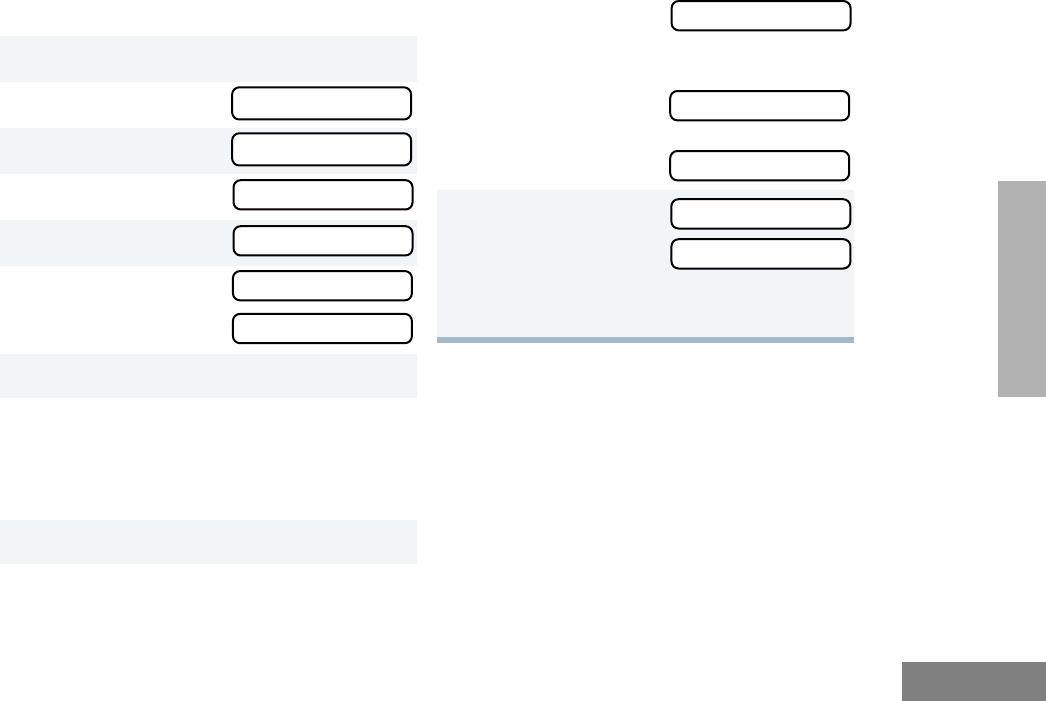
31
English
SCAN
Adding or Deleting Channels in a Scan List
To add or delete channels in a scan list:
1) to enter Menu Mode.
2+ or e until
3) to select
4+ or e until
5) to select
6+ or e until
or until
7) to conÞrm your selection.
8+ or e until you see the channel you
want to add or delete.
Note: You cannot delete the last remaining
channel in a scan list.
9) to conÞrm your selection.
PP
PPrr
rroo
oogg
ggrr
rraa
aamm
mm
LL
LLii
iiss
sstt
ttss
ss
PP
PPrr
rroo
oogg
ggrr
rraa
aamm
mm
LL
LLii
iiss
sstt
ttss
ss
SS
SScc
ccaa
aann
nn
LL
LLii
iiss
sstt
tt
SS
SScc
ccaa
aann
nn
LL
LLii
iiss
sstt
tt
AA
AAdd
dddd
dd
EE
EEnn
nntt
ttrr
rryy
yy??
??
DD
DDee
eell
llee
eett
ttee
ee
EE
EEnn
nntt
ttrr
rryy
yy??
??
10 If you added a channel,
you will see
ÐorÐ
If you deleted a channel,
you will see
) to conÞrm the deletion.
You will see
11 ( to return to
or to return to
ÐorÐ
Hold down ( to exit Menu Mode.
EE
EEnn
nntt
ttrr
rryy
yy
SS
SSaa
aavv
vvee
eedd
dd
DD
DDee
eell
llee
eett
ttee
ee??
??
EE
EEnn
nntt
ttrr
rryy
yy
DD
DDee
eell
llee
eett
ttee
eedd
dd
AA
AAdd
dddd
dd
EE
EEnn
nntt
ttrr
rryy
yy??
??
DD
DDee
eell
llee
eett
ttee
ee
EE
EEnn
nntt
ttrr
rryy
yy??
??
88C37_English.book Page 31 Wednesday, April 21, 1999 10:49 PM

32
English
SCAN
Prioritizing a Channel in a Scan List
You may want to check the activity on one or
two channels more frequently than others. You
can do this by assigning them priority:
Note: Even if there may be activity on a non-
priority channel, your radio will
automatically switch to an active priority
channel and indicate the activity with a
short tone.
Setting Priority Channels
Note: You cannot reprioritize a Priority 1
channel to Priority 2.
Priority Channel
Scanning Sequence
None speciÞed Ch1➠Ch2➠Ch3➠Ch4➠
Ch1
Channel 2
(Priority 1)
Ch2➠Ch1➠Ch2➠Ch3➠
Ch2➠Ch4➠Ch2➠ÉCh1
Channel 2
(Priority 1)
Channel 8
(Priority 2)
Ch2➠Ch1➠Ch8➠Ch3➠
Ch2➠Ch4➠Ch8➠ÉCh1
1) to enter Menu Mode.
2+ or e until
3) to select
4+ or e until
5) to select
6+ or e until
7) to select
8+ or e until
or until
9) to select the desired priority level.
10 + or e until you see the channel you
want to prioritize.
PP
PPrr
rroo
oogg
ggrr
rraa
aamm
mm
LL
LLii
iiss
sstt
ttss
ss
PP
PPrr
rroo
oogg
ggrr
rraa
aamm
mm
LL
LLii
iiss
sstt
ttss
ss
SS
SScc
ccaa
aann
nn
LL
LLii
iiss
sstt
tt
SS
SScc
ccaa
aann
nn
LL
LLii
iiss
sstt
tt
EE
EEdd
ddii
iitt
tt
PP
PPrr
rrii
iioo
oorr
rrii
iitt
ttyy
yy??
??
EE
EEdd
ddii
iitt
tt
PP
PPrr
rrii
iioo
oorr
rrii
iitt
ttyy
yy??
??
PP
PPrr
rrii
iioo
oorr
rrii
iitt
ttyy
yy
##
##11
11??
??
PP
PPrr
rrii
iioo
oorr
rrii
iitt
ttyy
yy
##
##22
22??
??
88C37_English.book Page 32 Wednesday, April 21, 1999 10:49 PM
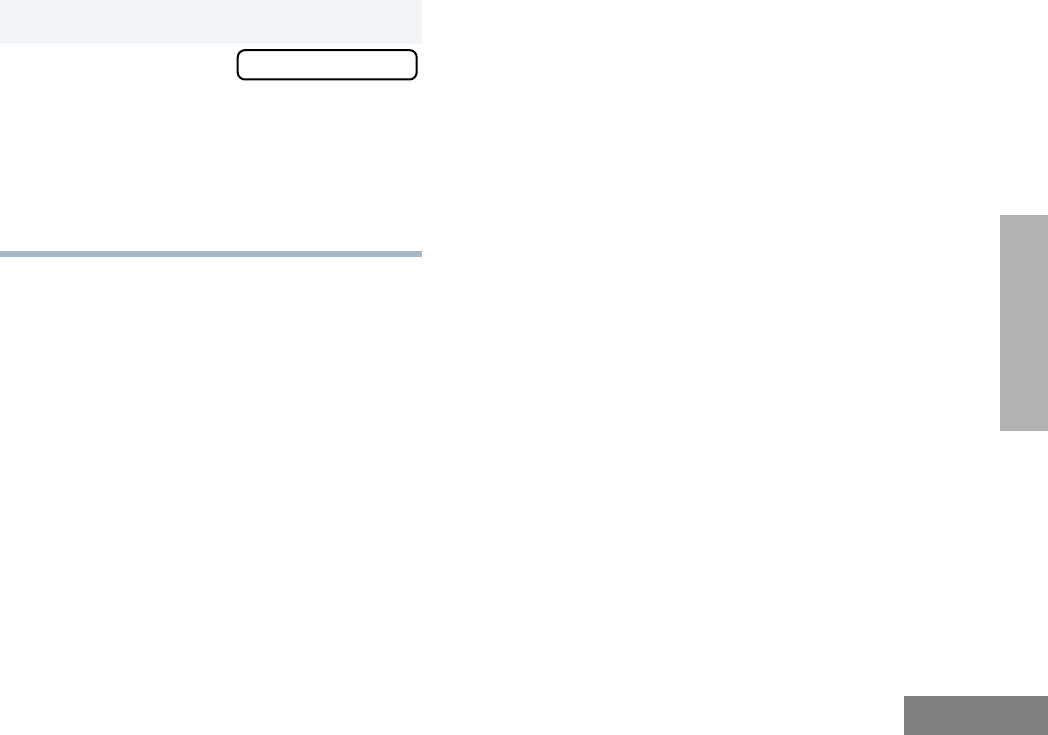
33
English
SCAN
11 ) to prioritize that channel.
12 ( to return to
ÐorÐ
Hold down ( to exit Menu Mode.
Note: If you want to reprioritize all channels,
you must Þrst delete each priority
channel from the scan list, and then
add it back.
EE
EEdd
ddii
iitt
tt
PP
PPrr
rrii
iioo
oorr
rrii
iitt
ttyy
yy??
??
88C37_English.book Page 33 Wednesday, April 21, 1999 10:49 PM

34
English
NOTES
NOTES
88C37_English.book Page 34 Wednesday, April 21, 1999 10:49 PM

35
English
PHONE
PHONE
If your radio has access to a telephone system,
you can make a phone call. To do this, your
radio must send an access code to a station
that connects it to a phone line. (Ask your dealer
for more details.) After completing a call, your
radio must send a deaccess code to hang up.
MAKING A PHONE CALL D
You can make a phone call using the
preprogrammed Phone button (see page 8) or
the radio menu. The D symbol appears on the
LCD screen when you are in Phone Mode.
To initiate a phone call:
Press the Phone button.
ÐorÐ
Do the following:
1Switch to the desired channel.
2) to enter Menu Mode.
3+ or e until PP
PPhh
hhoo
oonn
nnee
ee
4) to select
5You will hear a series of tones indicating that
an access code is being sent automatically.
You will also see your access code displayed;
ÐorÐ
when using the keypad microphone only,
enter your access code using the keypad.
6When you hear a dial tone, enter or select a
phone number:
when using the keypad microphone only,
enter the phone number using the keypad.
ÐorÐ
+ or e to select a number from the
phone list.
ÐorÐ
when using a keypad microphone only,
a Press and release the preprogrammed
Speed Dial button (see page 9) to use the
Speed Dial feature.
b Press the key (1 to 8) corresponding to the
number you want to call,
Ðor-
press Ò0Ó if you want to call the last
number dialed.
PP
PPhh
hhoo
oonn
nnee
ee
88C37_English.book Page 35 Wednesday, April 21, 1999 10:49 PM

36
English
PHONE
MODIFYING THE PHONE LIST K
You can modify a phone list in one of the
following ways:
¥ Add an entry
¥ Delete an entry
¥ Edit an existing entry
¥ Edit an Access/Deaccess code
When you are modifying the phone list, the
K symbol will appear on the display.
Note: Your radio cannot receive any calls while
you are modifying the phone list.
Adding an Entry (when using the keypad
microphone only)
To add an entry:
Note: To redial the last number dialed (if not
using Speed Dial), do not choose a
number. Proceed to step 7.
Alternatively, if you entered your
access code using the keypad, press
the e key once to access the last
number dialed; then press and release
the PTT.
7To end a phone call, do one of the following:
If your radio has the deaccess code
preprogrammed, proceed to step 8.
ÐorÐ
Enter the deaccess code using the keypad.
8Press the Phone button to exit Phone Mode.
ÐorÐ
( to exit Phone Mode
and return to
ÐorÐ
Hold down ( to exit Menu Mode.
PP
PPhh
hhoo
oonn
nnee
ee
1) to enter Menu Mode.
2+ or e until
3) to select
4+ or e until
5) to select
PP
PPrr
rroo
oogg
ggrr
rraa
aamm
mm
LL
LLii
iiss
sstt
ttss
ss
PP
PPrr
rroo
oogg
ggrr
rraa
aamm
mm
LL
LLii
iiss
sstt
ttss
ss
PP
PPhh
hhoo
oonn
nnee
ee
LL
LLii
iiss
sstt
tt
PP
PPhh
hhoo
oonn
nnee
ee
LL
LLii
iiss
sstt
tt
88C37_English.book Page 36 Wednesday, April 21, 1999 10:49 PM
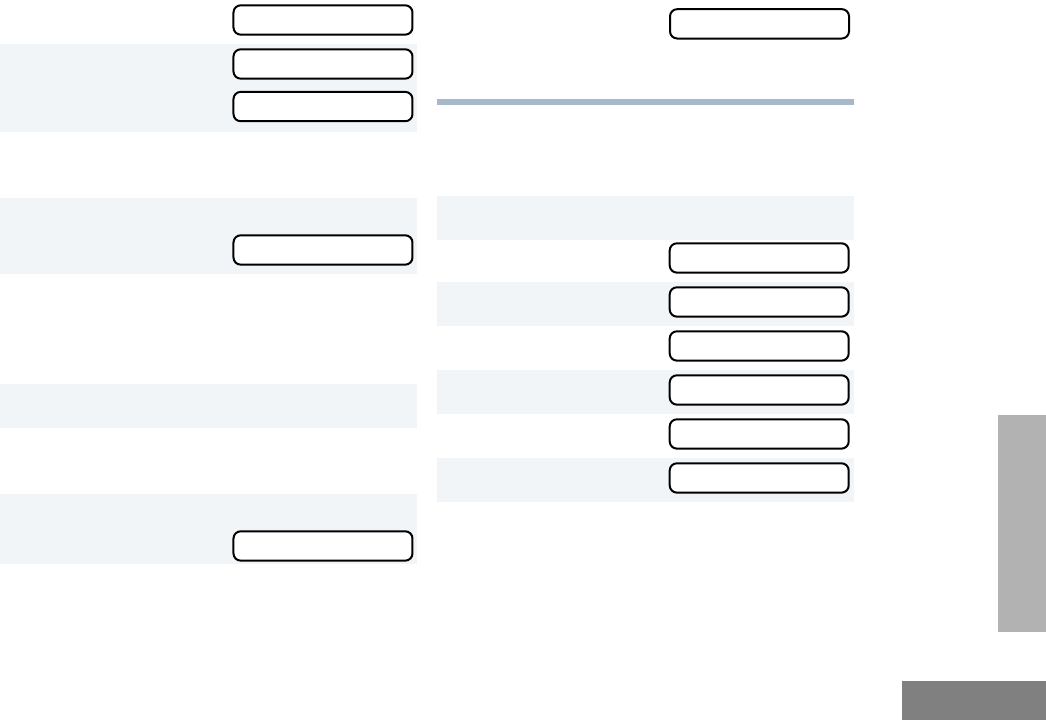
37
English
PHONE
Deleting an Entry:
To delete an entry:
6+ or e until
7) to select
You will see
8Use the keypad to enter the name (see
page 11).
9) to store the name.
You will see
10 Use the keypad to enter the phone number. You
can also add a dash (press f) and a Pause
Indicator (hold down # until the # character
on the display changes to a ÒPÓ).
11 ) to select the phone number.
12 + or e until you see the location in the
list where you want to store the phone number.
13 ) to store the phone number.
You will see
AA
AAdd
dddd
dd
EE
EEnn
nntt
ttrr
rryy
yy??
??
AA
AAdd
dddd
dd
EE
EEnn
nntt
ttrr
rryy
yy??
??
EE
EEnn
nntt
ttee
eerr
rr
NN
NNaa
aamm
mmee
ee
EE
EEnn
nntt
ttee
eerr
rr
PP
PPhh
hhoo
oonn
nnee
ee
##
##
EE
EEnn
nntt
ttrr
rryy
yy
SS
SSaa
aavv
vvee
eedd
dd
14 ( to return to
ÐorÐ
Hold down
(
to exit Menu Mode.
1) to enter Menu Mode.
2+ or e until
3) to select
4+ or e until
5) to select
6+ or e until
7) to select
8+ or e until you see the entry you
want to delete.
AA
AAdd
dddd
dd
EE
EEnn
nntt
ttrr
rryy
yy??
??
PP
PPrr
rroo
oogg
ggrr
rraa
aamm
mm
LL
LLii
iiss
sstt
ttss
ss
PP
PPrr
rroo
oogg
ggrr
rraa
aamm
mm
LL
LLii
iiss
sstt
ttss
ss
PP
PPhh
hhoo
oonn
nnee
ee
LL
LLii
iiss
sstt
tt
PP
PPhh
hhoo
oonn
nnee
ee
LL
LLii
iiss
sstt
tt
DD
DDee
eell
llee
eett
ttee
ee
EE
EEnn
nntt
ttrr
rryy
yy??
??
DD
DDee
eell
llee
eett
ttee
ee
EE
EEnn
nntt
ttrr
rryy
yy??
??
88C37_English.book Page 37 Wednesday, April 21, 1999 10:49 PM
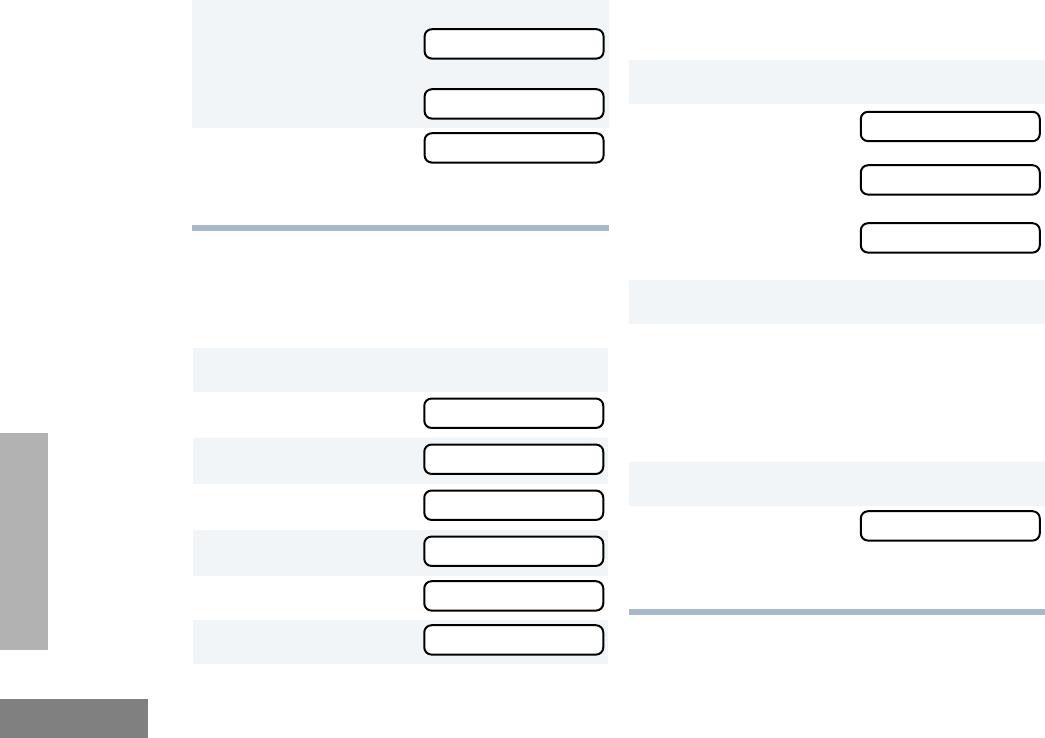
38
English
PHONE
Editing an Entry (when using the keypad
microphone only)
To edit an entry:
9) to select the entry.
You will see
) again to conÞrm the deletion.
You will see
10 ( to return to
ÐorÐ
Hold down ( to exit Menu Mode.
1) to enter Menu Mode.
2+ or e until
3) to select
4+ or e until
5) to select
6+ or e until
7) to select
DD
DDee
eell
llee
eett
ttee
ee??
??
EE
EEnn
nntt
ttrr
rryy
yy
DD
DDee
eell
llee
eett
ttee
eedd
dd
DD
DDee
eell
llee
eett
ttee
ee
EE
EEnn
nntt
ttrr
rryy
yy??
??
PP
PPrr
rroo
oogg
ggrr
rraa
aamm
mm
LL
LLii
iiss
sstt
ttss
ss
PP
PPrr
rroo
oogg
ggrr
rraa
aamm
mm
LL
LLii
iiss
sstt
ttss
ss
PP
PPhh
hhoo
oonn
nnee
ee
LL
LLii
iiss
sstt
tt
PP
PPhh
hhoo
oonn
nnee
ee
LL
LLii
iiss
sstt
tt
EE
EEdd
ddii
iitt
tt
EE
EEnn
nntt
ttrr
rryy
yy??
??
EE
EEdd
ddii
iitt
tt
EE
EEnn
nntt
ttrr
rryy
yy??
??
8+ or e until you see the entry you want
to edit.
9) to select the entry.
10 + or e until
to edit the name,
ÐorÐ until
to edit the phone number,
ÐorÐ until
to edit the location in the phone list.
11 ) to conÞrm your selection.
12 Use the keypad to edit the entry (see page
11).
ÐorÐ
+ or e until you see the location
where you want to store the phone number.
13 ) to store the information.
14 ( to return to
ÐorÐ
Hold down
(
to exit Menu Mode.
EE
EEdd
ddii
iitt
tt
NN
NNaa
aamm
mmee
ee??
??
EE
EEdd
ddii
iitt
tt
NN
NNuu
uumm
mmbb
bbee
eerr
rr??
??
EE
EEdd
ddii
iitt
tt
LL
LLoo
oocc
ccaa
aatt
ttii
iioo
oonn
nn??
??
EE
EEdd
ddii
iitt
tt
EE
EEnn
nntt
ttrr
rryy
yy??
??
88C37_English.book Page 38 Wednesday, April 21, 1999 10:49 PM
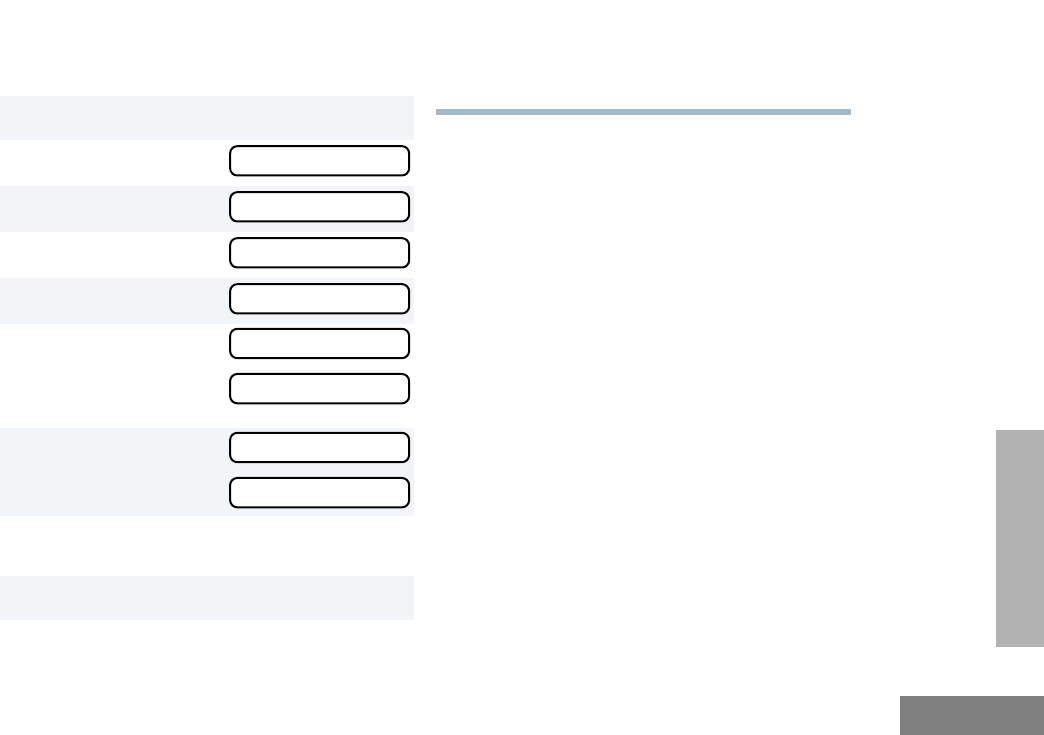
39
English
PHONE
Editing an Access/Deaccess Code (when using
the keypad microphone only)
To edit an access/deaccess code:
1) to enter Menu Mode.
2+ or e until
3) to select
4+ or e until
5) to select
6+ or e until
ÐorÐ until
7) to select
ÐorÐ
8Enter the number using the keypad
microphone.
9) to select the entry.
PP
PPrr
rroo
oogg
ggrr
rraa
aamm
mm
LL
LLii
iiss
sstt
ttss
ss
PP
PPrr
rroo
oogg
ggrr
rraa
aamm
mm
LL
LLii
iiss
sstt
ttss
ss
EE
EEdd
ddii
iitt
tt
CC
CCoo
oodd
ddee
eess
ss??
??
EE
EEdd
ddii
iitt
tt
CC
CCoo
oodd
ddee
eess
ss??
??
AA
AAcc
cccc
ccee
eess
ssss
ss
CC
CCoo
oodd
ddee
ee??
??
DD
DDee
eeaa
aacc
cccc
ccee
eess
ssss
ss
CC
CCoo
oodd
ddee
ee??
??
AA
AAcc
cccc
ccee
eess
ssss
ss
CC
CCoo
oodd
ddee
ee??
??
DD
DDee
eeaa
aacc
cccc
ccee
eess
ssss
ss
CC
CCoo
oodd
ddee
ee??
??
10 + or e to edit another code.
ÐorÐ
Hold down ( to exit Menu Mode.
88C37_English.book Page 39 Wednesday, April 21, 1999 10:49 PM

40
English
PHONE
Notes
88C37_English.book Page 40 Wednesday, April 21, 1999 10:49 PM
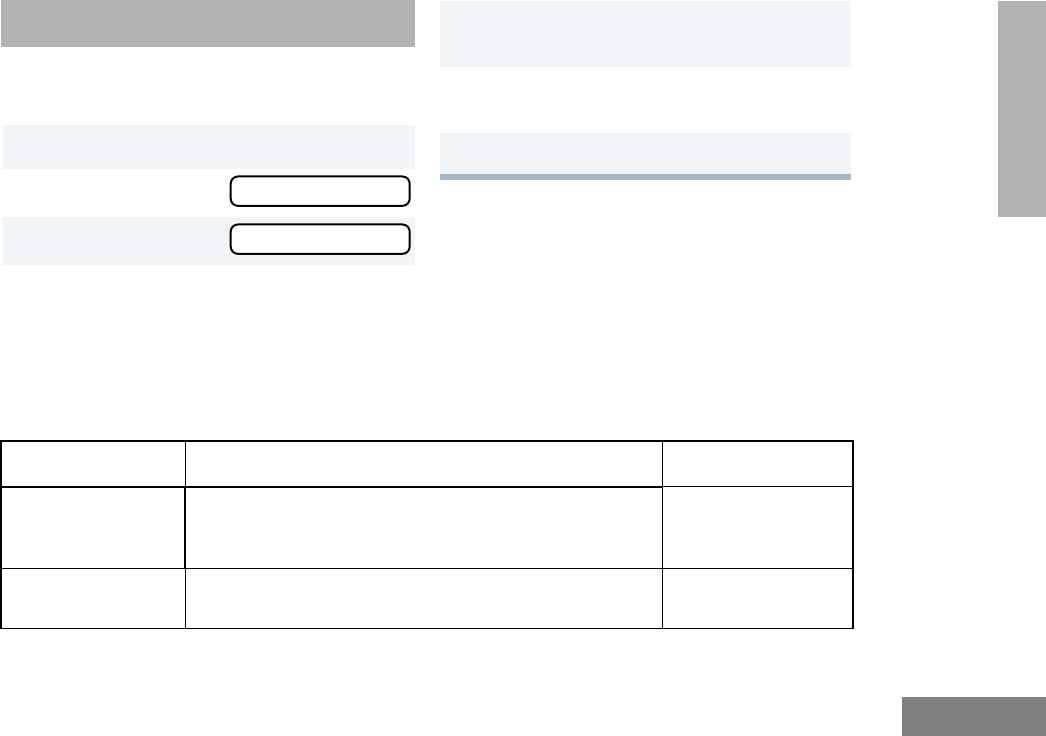
41
English
AUDIO/TONE
SETTINGS
AUDIO/TONE SETTINGS
You can customize the audio and tone feature
settings on your radio.
1) to enter Menu Mode.
2+ or e until
3) to select
4+ or e until you see the feature you
want to change. (Refer to the table below.)
AA
AAuu
uudd
ddii
iioo
oo//
//TT
TToo
oonn
nnee
eess
ss
AA
AAuu
uudd
ddii
iioo
oo//
//TT
TToo
oonn
nnee
eess
ss
5) to select the feature. You will see the
featureÕs current setting.
6+ or e for available settings. (Refer to
the table below.)
7) to select the desired setting.
Audio/Tone Settings
Feature What it Does Settings
Alert Vol Lvl Makes the volume level of the audio and alert tones
independent. These two volume levels can be adjusted
independently.
Ind Alert Off
Ind Alert On
Tone Disable Turns all tones on or off. Tones On
Tones Off
88C37_English.book Page 41 Wednesday, April 21, 1999 10:49 PM
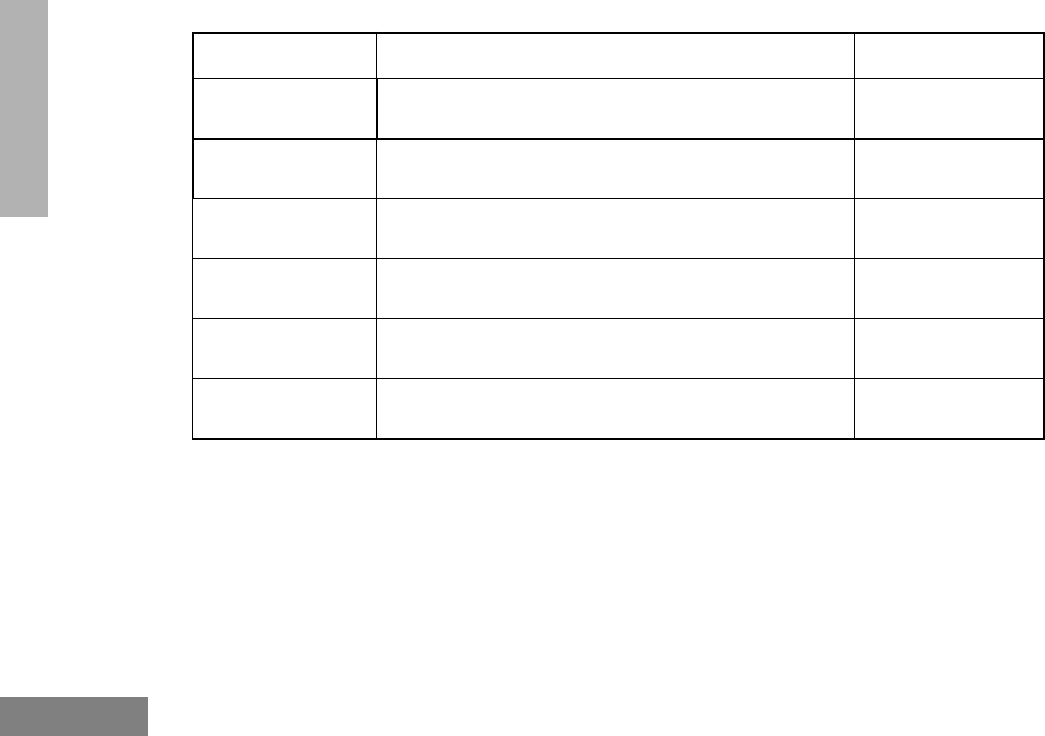
42
English
AUDIO/TONE
SETTINGS
Name Tone Tag Assigns a speciÞc tone to all calls from a speciÞc user
(see page 26 for details).
Standard
Alert #1 Ð #7
Call Tone Tag Assigns a speciÞc tone when receiving a speciÞc type of
radio call (see page 27 for details).
Standard
Alert #1 Ð #7
Msg Tone Tag Assigns a speciÞc tone when receiving a speciÞc
message (see page 26 for details).
Standard
Alert #1 Ð #7
Escalert Gradually increases the volume of the alarm tones when
a call is not answered.
Escalert On
Escalert Off
Companding
(XPandª)
Approximates the same audio quality for 12.5kHz
channels to that of 25kHz channels.
Compand On
Compand Off
Keypad Tones Turns keypad tones on or off. Tones On
Tones Off
Audio/Tone Settings
Feature What it Does Settings
88C37_English.book Page 42 Wednesday, April 21, 1999 10:49 PM
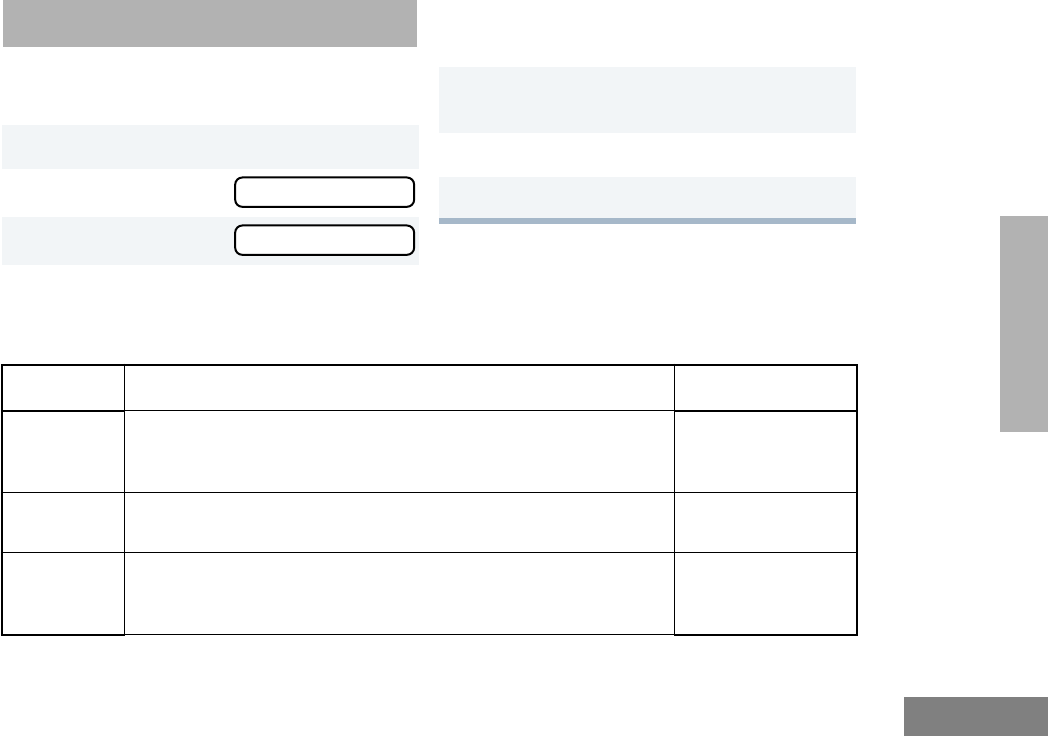
43
English
UTILITIES
UTILITIES
You can customize some of your radioÕs
features by:
1) to enter Menu Mode.
2+ or e until
3) to select
UU
UUtt
ttii
iill
llii
iitt
ttii
iiee
eess
ss
UU
UUtt
ttii
iill
llii
iitt
ttii
iiee
eess
ss
4+ or e until you see the feature you
want to change (see table below).
5) to select the feature. You will see the
featureÕs current setting.
6+ or e for available settings.
7) to select the desired setting.
Utilities Features
Feature What it Does Settings
Power
Level
Changes the power level of the radio to high, low, or auto (see
page 25).
Power High
Power Low
Power Auto
Clock Sets the time (see page 45). Set Time
Display Clock
Reminder
Alarm
Sets the alarm and turns it on or off (see page 45). Alarm On
Alarm Off
Set Time
88C37_English.book Page 43 Wednesday, April 21, 1999 10:49 PM
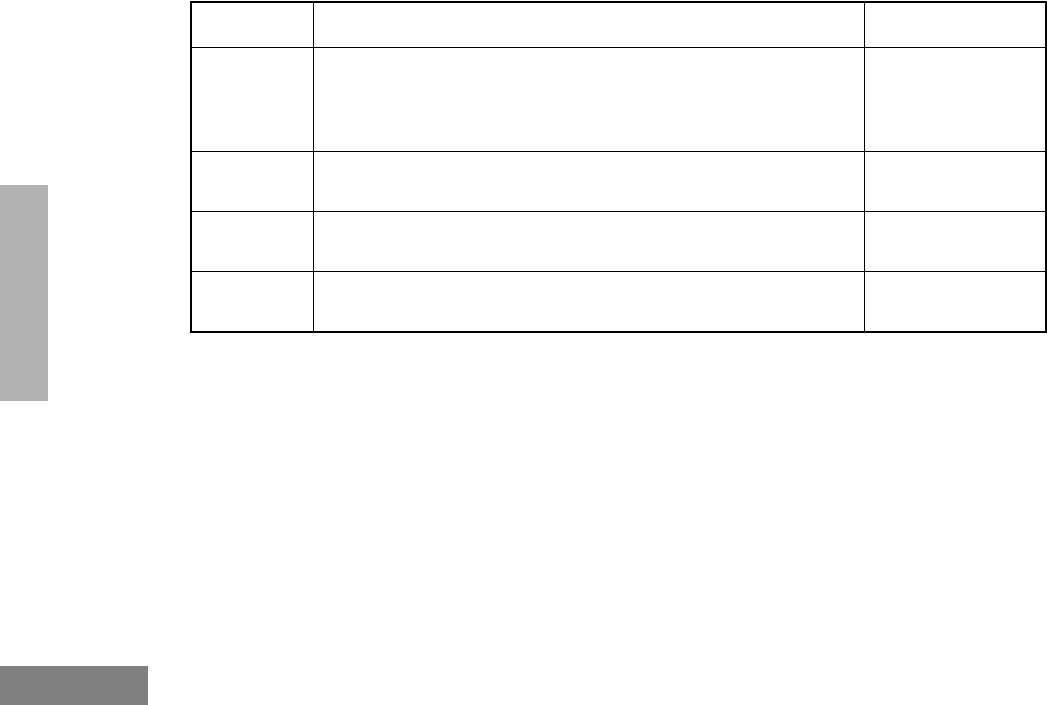
44
English
UTILITIES
Language
Selection
Allows you to select the language displayed on the display. English
Spanish
Portuguese
French
Option
board
Activates/deactivates the option board installed in your radio. Opt Board On
Opt Board Off
Light
Disable
Toggles all lights on or off including LEDs, display lights, and
keypad lights.
Lights On
Lights Off
Software
Ver #
Displays the radioÕs software version number. ÑÑ
Utilities Features
Feature What it Does Settings
88C37_English.book Page 44 Wednesday, April 21, 1999 10:49 PM
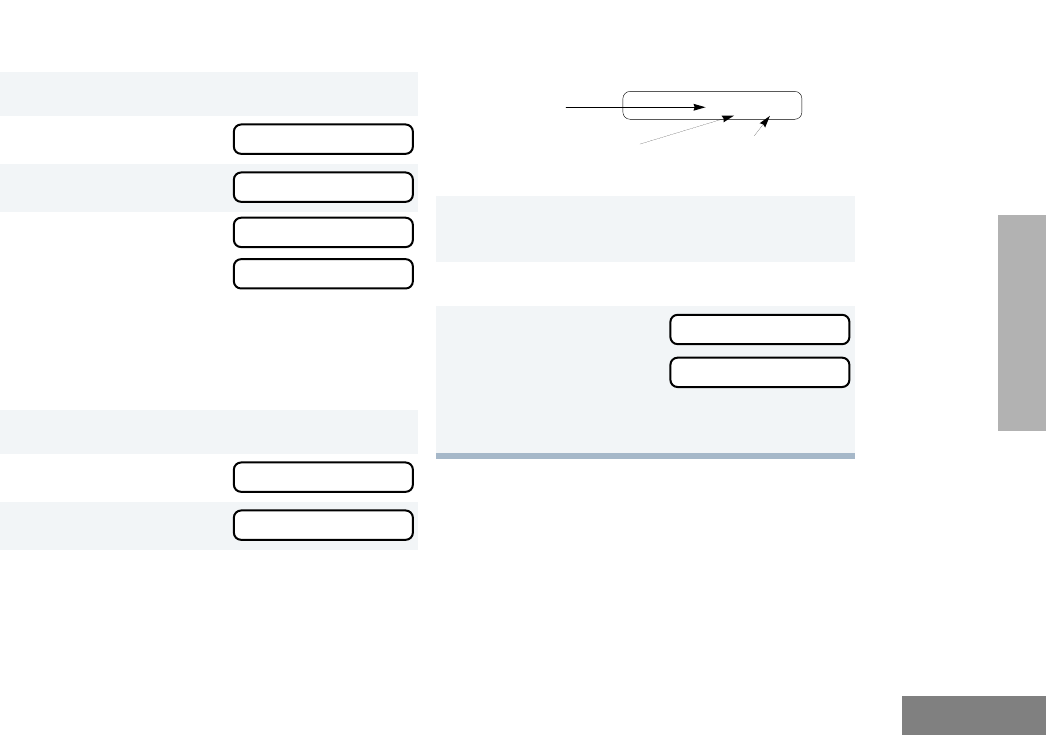
45
English
UTILITIES
SETTING THE TIME
To set the time:
1) to enter Menu Mode.
2+ or e until
3) to select
4+ or e until
ÐorÐ until
Note: You must access the clock menu to
select AM/PM or Ò24 hrÓ. This selection
cannot be made from Reminder Alarm
menu.
5) to conÞrm your selection.
6+ or e until
7) to select
UU
UUtt
ttii
iill
llii
iitt
ttii
iiee
eess
ss
UU
UUtt
ttii
iill
llii
iitt
ttii
iiee
eess
ss
RR
RRee
eemm
mmii
iinn
nndd
ddee
eerr
rr
AA
AAll
llaa
aarr
rrmm
mm
CC
CCll
lloo
oocc
cckk
kk
SS
SSee
eett
tt
TT
TTii
iimm
mmee
ee??
??
SS
SSee
eett
tt
TT
TTii
iimm
mmee
ee??
??
8When a setting (e.g., ÒhourÓ) is blinking, you
can change it with + or e.
9f to proceed to the next setting (e.g.,
from hour to minutes).
10 ) to save your changes.
11 ( to return to
or to return to
ÐorÐ
Hold down ( to exit Menu Mode.
Hour
(AM or PM)
(AM/PM or 24 hr)
3:05 PM
Minutes
RR
RRee
eemm
mmii
iinn
nndd
ddee
eerr
rr
AA
AAll
llaa
aarr
rrmm
mm
CC
CCll
lloo
oocc
cckk
kk
88C37_English.book Page 45 Wednesday, April 21, 1999 10:49 PM
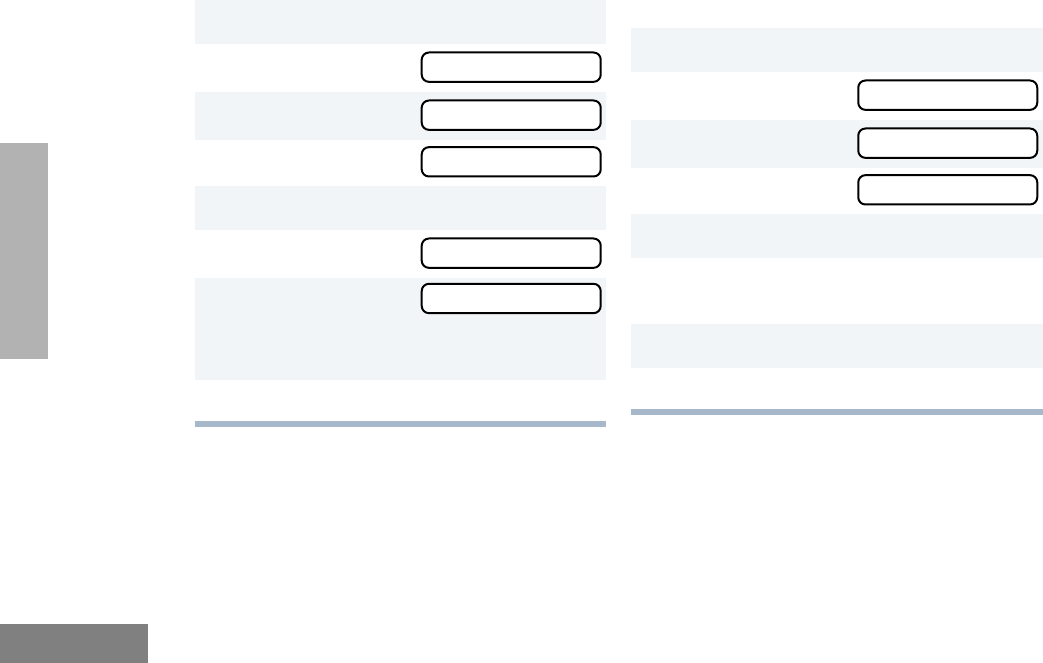
46
English
UTILITIES
DISPLAYING THE TIME
To display the time:
SELECTING THE DISPLAY
LANGUAGE
To select the display language:
1) to enter Menu Mode.
2+ or e until
3) to select
4+ or e until
5) to conÞrm your selection.
6+ or e until
7) to select
The radio will display the time for a
preprogrammed duration.
8( to exit the menu.
UU
UUtt
ttii
iill
llii
iitt
ttii
iiee
eess
ss
UU
UUtt
ttii
iill
llii
iitt
ttii
iiee
eess
ss
CC
CCll
lloo
oocc
cckk
kk
DD
DDii
iiss
sspp
ppll
llaa
aayy
yy
CC
CCll
lloo
oocc
cckk
kk??
??
DD
DDii
iiss
sspp
ppll
llaa
aayy
yy
CC
CCll
lloo
oocc
cckk
kk??
??
1) to enter Menu Mode.
2+ or e until
3) to select
4+ or e until
5) to conÞrm your selection.
6+ or e until desired language is
displayed.
7) to select desired language.
8( to exit the menu.
UU
UUtt
ttii
iill
llii
iitt
ttii
iiee
eess
ss
UU
UUtt
ttii
iill
llii
iitt
ttii
iiee
eess
ss
LL
LLaa
aann
nngg
gguu
uuaa
aagg
ggee
ee
SS
SSee
eell
llee
eecc
cctt
tt
88C37_English.book Page 46 Wednesday, April 21, 1999 10:49 PM

47
English
SAFETY AND
WARRANTY
SAFETY AND WARRANTY
SAFE AND EFFICIENT OPERATION
OF MOTOROLA TWO-WAY RADIOS
Exposure to Radio Frequency Energy
National and International Standards
and Guidelines
Your Motorola Two-Way Radio, which
generates and radiates radio frequency (RF)
electromagnetic energy (EME), is designed to
comply with the following National and
International Standards and Guidelines
regarding exposure of human beings to radio
frequency electromagnetic energy:
¥ Federal Communications Commission
Report and Order No. FCC 96-326 (August
1996)
¥ American National Standards Institute
(C95.1 - 1992)
¥ National Council on Radiation Protection
and Measurements (NCRP - 1986)
¥ International Commission on Non-Ionizing
Radiation Protection (ICNRP - 1986)
¥ European Committee for Electrotechnical
Standardisation (CENELEC):
To assure optimal radio performance and that
human exposure to radio frequency
electromagnetic energy is within the guidelines
set forth in the above standards, always
adhere to the following procedures:
ENV. 50166-
1 1995 E
Human Exposure to
Electromagnetic Fields Low
Frequency (0Hz to 10kHz)
ENV. 50166-
2 1995 E
Human Exposure to
Electromagnetic Fields High
Frequency (10kHz to
300GHz)
Proceedings
of SC211/8
1996
Safety Considerations for
Human Exposure to E.M.F.s
from Mobile
Telecommunications
Equipment (M.T.E.) in the
Frequency Range
30MHz - 6 GHz (E.M.F. -
Electromagnetic Fields)
88C37_English.book Page 47 Wednesday, April 21, 1999 10:49 PM

48
English
SAFETY AND
WARRANTY
ELECTROMAGNETIC
INTERFERENCE/COMPATIBILITY
Note: Nearly every electronic device is
susceptible to electromagnetic
interference (EMI) if inadequately
shielded, designed, or otherwise
conÞgured for electromagnetic
compatibility.
¥ To avoid electromagnetic interference
and/or compatibility conßicts, turn off your
radio in any facility where posted notices
instruct you to do so. Hospitals or health
care facilities may be using equipment that
is sensitive to external RF energy.
¥ When instructed to do so, turn off your radio
when on board an aircraft. Any use of a
radio must be in accordance with airline
regulations or crew instructions.
OPERATIONAL WARNINGS
Vehicles with an Air Bag
Do not place a radio in the area over an air bag
or in the air bag deployment area. Air bags
inßate with great force. If a radio is placed in
the air bag deployment area and the air bag
inßates, the radio may be propelled with great
force and cause serious injury to occupants of
the vehicle.
Potentially Explosive Atmospheres
Turn off your two-way radio when you are in
any area with a potentially explosive
atmosphere, unless it is a radio type especially
qualiÞed for use in such areas (for example,
Factory Mutual or CENELEC approved).
Sparks in a potentially explosive atmosphere
can cause an explosion or Þre resulting in
bodily injury or even death.
!
W A R N I N G
!
88C37_English.book Page 48 Wednesday, April 21, 1999 10:49 PM
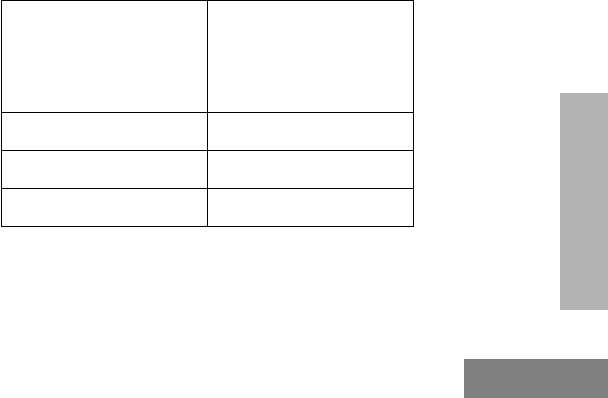
49
English
SAFETY AND
WARRANTY
Blasting Caps and Blasting Areas
To avoid possible interference with blasting
operations, turn off your radio when you are
near electrical blasting caps, in a blasting area,
or in areas posted: ÒTurn off two-way radio.Ó
Obey all signs and instructions.
Note: The areas with potentially explosive
atmospheres referred to above include
fueling areas such as: below decks on
boats; fuel or chemical transfer or
storage facilities; areas where the air
contains chemicals or particles, such
as grain, dust, or metal powders; and
any other area where you would
normally be advised to turn off a
vehicle engine. Areas with potentially
explosive atmospheres are often but
not always posted.
Mobile Radio Operation and EME Exposure
To assure optimal radio performance and that
human exposure to radio frequency
electromagnetic energy is within the guidelines
referenced earlier in this document, transmit
only when people inside and outside the
vehicle are at least the minimum distance away
from a properly installed, externally mounted
antenna.
Table 1 lists the minimum distance for several
different ranges of radiated power.
Table 1: Radiated Power and Distance
Radiated Power of
Vehicle-installed
Mobile Two-way
Radio
Minimum Distance
From Transmitting
Antenna
7 to 15 Watts 1 Foot (30.5 cm)
16 to 50 Watts 2 Feet (61 cm)
More than 50 Watts 3 Feet (91.5 cm)
88C37_English.book Page 49 Wednesday, April 21, 1999 10:49 PM

50
English
SAFETY AND
WARRANTY
Mobile Antenna Installation
Install the vehicle antenna external to the
vehicle and in accordance with:
¥ The requirements of the antenna
manufacturer/supplier
¥ Instructions in the Radio Installation Manual
CONTROL STATION OPERATION
When radio equipment is used to operate as a
control station, it is important that the antenna
be installed outside the building and away from
places where people may be in close proximity.
Note: Refer to Table on page 49 for rated
power and minimum distant values for
transmitting antennas.
LIMITED WARRANTY
MOTOROLA COMMUNICATION PRODUCTS
I. WHAT THIS WARRANTY COVERS AND
FOR HOW LONG:
MOTOROLA INC. (ÒMOTOROLAÓ) warrants the
MOTOROLA manufactured Communication
Products listed below (ÒProductÓ) against defects
in material and workmanship under normal use
and service for a period of time from the date of
purchase as scheduled below:
_______ Mobile Units Two (2) Years
Product Accessories One (1) Year
Motorola, at its option, will at no charge either
repair the Product (with new or reconditioned
parts), replace it (with a new or reconditioned
Product), or refund the purchase price of the
Product during the warranty period provided it is
returned in accordance with the terms of this
warranty. Replaced parts or boards are
warranted for the balance of the original
applicable warranty period. All replaced parts of
Product shall become the property of
MOTOROLA.
88C37_English.book Page 50 Wednesday, April 21, 1999 10:49 PM

51
English
SAFETY AND
WARRANTY
This express limited warranty is extended by
MOTOROLA to the original end user purchaser
only and is not assignable or transferable to any
other party. This is the complete warranty for the
Product manufactured by MOTOROLA.
MOTOROLA assumes no obligations or liability
for additions or modiÞcations to this warranty
unless made in writing and signed by an ofÞcer
of MOTOROLA. Unless made in a separate
agreement between MOTOROLA and the
original end user purchaser, MOTOROLA does
not warrant the installation, maintenance or
service of the Product.
MOTOROLA cannot be responsible in any way
for any ancillary equipment not furnished by
MOTOROLA which is attached to or used in
connection with the Product, or for operation of
the Product with any ancillary equipment, and all
such equipment is expressly excluded from this
warranty. Because each system which may use
the Product is unique, MOTOROLA disclaims
liability for range, coverage, or operation of the
system as a whole under this warranty.
II. GENERAL PROVISIONS:
This warranty sets forth the full extent of
MOTOROLA's responsibilities regarding the
Product. Repair, replacement or refund of the
purchase price, at MOTOROLAÕs option, is the
exclusive remedy. THIS WARRANTY IS GIVEN
IN LIEU OF ALL OTHER EXPRESS
WARRANTIES. IMPLIED WARRANTIES,
INCLUDING WITHOUT LIMITATION, IMPLIED
WARRANTIES OF MERCHANTABILITY AND
FITNESS FOR A PARTICULAR PURPOSE,
ARE LIMITED TO THE DURATION OF THIS
LIMITED WARRANTY. IN NO EVENT SHALL
MOTOROLA BE LIABLE FOR DAMAGES IN
EXCESS OF THE PURCHASE PRICE OF THE
PRODUCT, FOR ANY LOSS OF USE, LOSS OF
TIME, INCONVENIENCE, COMMERCIAL
LOSS, LOST PROFITS OR SAVINGS OR
OTHER INCIDENTAL, SPECIAL OR
CONSEQUENTIAL DAMAGES ARISING OUT
OF THE USE OR INABILITY TO USE SUCH
PRODUCT, TO THE FULL EXTENT SUCH MAY
BE DISCLAIMED BY LAW.
88C37_English.book Page 51 Wednesday, April 21, 1999 10:49 PM

52
English
SAFETY AND
WARRANTY
III. STATE LAW RIGHTS:
SOME STATES DO NOT ALLOW THE
EXCLUSION OR LIMITATION OF INCIDENTAL
OR CONSEQUENTIAL DAMAGES OR
LIMITATION ON HOW LONG AN IMPLIED
WARRANTY LASTS, SO THE ABOVE
LIMITATION OR EXCLUSIONS MAY NOT
APPLY.
This warranty gives speciÞc legal rights, and
there may be other rights which may vary from
state to state.
IV. HOW TO GET WARRANTY SERVICE:
You must provide proof of purchase (bearing the
date of purchase and Product item serial number)
in order to receive warranty service and, also,
deliver or send the Product item, transportation
and insurance prepaid, to an authorized warranty
service location. Warranty service will be
provided by Motorola through one of its
authorized warranty service locations. If you Þrst
contact the company which sold you the Product
(e.g., dealer or communication service provider),
it can facilitate your obtaining warranty service.
You can also call Motorola at 1-800-927-2744
US/Canada.
V. WHAT THIS WARRANTY DOES NOT
COVER:
A Defects or damage resulting from use of the
Product in other than its normal and
customary manner.
B Defects or damage from misuse, accident,
water, or neglect.
C Defects or damage from improper testing,
operation, maintenance, installation,
alteration, modiÞcation, or adjustment.
D Breakage or damage to antennas unless
caused directly by defects in material
workmanship.
E A Product subjected to unauthorized
Product modiÞcations, disassemblies or
repairs (including, without limitation, the
addition to the Product of non-Motorola
supplied equipment) which adversely affect
performance of the Product or interfere with
Motorola's normal warranty inspection and
testing of the Product to verify any warranty
claim.
F Product which has had the serial number
removed or made illegible.
G Freight costs to the repair depot.
88C37_English.book Page 52 Wednesday, April 21, 1999 10:49 PM

53
English
SAFETY AND
WARRANTY
H A Product which, due to illegal or
unauthorized alteration of the software/
Þrmware in the Product, does not function in
accordance with MOTOROLAÕs published
speciÞcations or the FCC type acceptance
labeling in effect for the Product at the time
the Product was initially distributed from
MOTOROLA.
I Scratches or other cosmetic damage to
Product surfaces that does not affect the
operation of the Product.
J Normal and customary wear and tear.
VI. PATENT AND SOFTWARE PROVISIONS:
MOTOROLA will defend, at its own expense, any
suit brought against the end user purchaser to the
extent that it is based on a claim that the Product
or parts infringe a United States patent, and
MOTOROLA will pay those costs and damages
Þnally awarded against the end user purchaser in
any such suit which are attributable to any such
claim, but such defense and payments are
conditioned on the following:
A that MOTOROLA will be notiÞed promptly in
writing by such purchaser of any notice of
such claim;
B that MOTOROLA will have sole control of the
defense of such suit and all negotiations for
its settlement or compromise; and
C should the Product or parts become, or in
MOTOROLAÕs opinion be likely to become,
the subject of a claim of infringement of a
United States patent, that such purchaser will
permit MOTOROLA, at its option and
expense, either to procure for such purchaser
the right to continue using the Product or
parts or to replace or modify the same so that
it becomes non-infringing or to grant such
purchaser a credit for the Product or parts as
depreciated and accept its return. The
depreciation will be an equal amount per year
over the lifetime of the Product or parts as
established by MOTOROLA.
MOTOROLA will have no liability with respect to
any claim of patent infringement which is based
upon the combination of the Product or parts
furnished hereunder with software, apparatus or
devices not furnished by MOTOROLA, nor will
MOTOROLA have any liability for the use of
ancillary equipment or software not furnished by
MOTOROLA which is attached to or used in
connection with the Product. The foregoing states
the entire liability of MOTOROLA with respect to
infringement of patents by the Product or any
parts thereof.
88C37_English.book Page 53 Wednesday, April 21, 1999 10:49 PM

54
English
SAFETY AND
WARRANTY
Laws in the United States and other countries
preserve for MOTOROLA certain exclusive rights
for copyrighted MOTOROLA software such as
the exclusive rights to reproduce in copies and
distribute copies of such Motorola software.
MOTOROLA software may be used in only the
Product in which the software was originally
embodied and such software in such Product
may not be replaced, copied, distributed,
modiÞed in any way, or used to produce any
derivative thereof. No other use including,
without limitation, alteration, modiÞcation,
reproduction, distribution, or reverse engineering
of such MOTOROLA software or exercise of
rights in such MOTOROLA software is permitted.
No license is granted by implication, estoppel or
otherwise under MOTOROLA patent rights or
copyrights.
VII. GOVERNING LAW:
This Warranty is governed by the laws of the
State of Illinois, USA.
88C37_English.book Page 54 Wednesday, April 21, 1999 10:49 PM
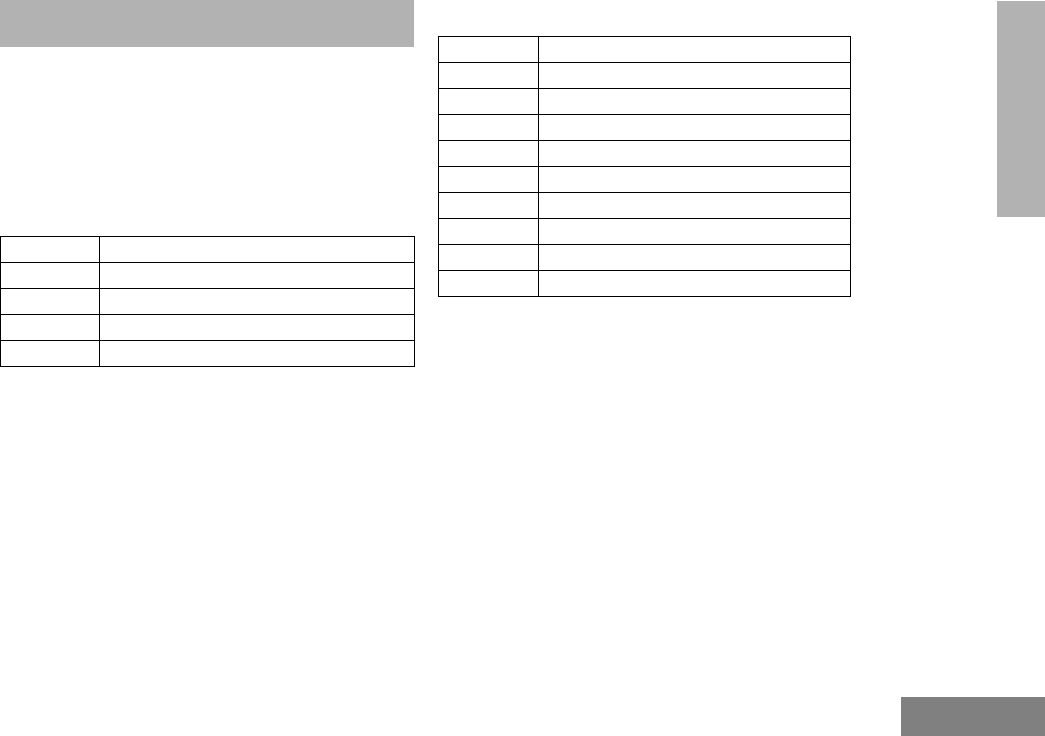
55
English
ACCESSORIES
ACCESSORIES
Motorola offers a number of accessories to
enhance the productivity of your two-way radio.
Many of the available accessories are listed
below. For a complete list, see your Motorola
dealer.
AUDIO
MOUNTING
RMN4025 Compact Remote Speaker Microphone
RMN4026 Enhanced DTMF Keypad Microphone
RMN4038 Heavy Duty Microphone
RSN4001 External Speaker 13W
HSN8145 External Speaker 7.5W
GLN7324 Low ProÞle Trunnion
RLN4780 High ProÞle Trunnion
HLN8097Ô Removable Slide Mount
RLN4779 Key Lock Mount
RLN4774 3 Point Lowband Mount
RLN4782 DIN Mounting Kit (in dash)
RLN4802 Remote Mount Kit
RKN4077 Remote Mount Cable - 3 m
RKN4078 Remote Mount Cable - 5 m
RKN4079 Remote Mount Cable - 7 m
88C37_English.book Page 55 Wednesday, April 21, 1999 10:49 PM
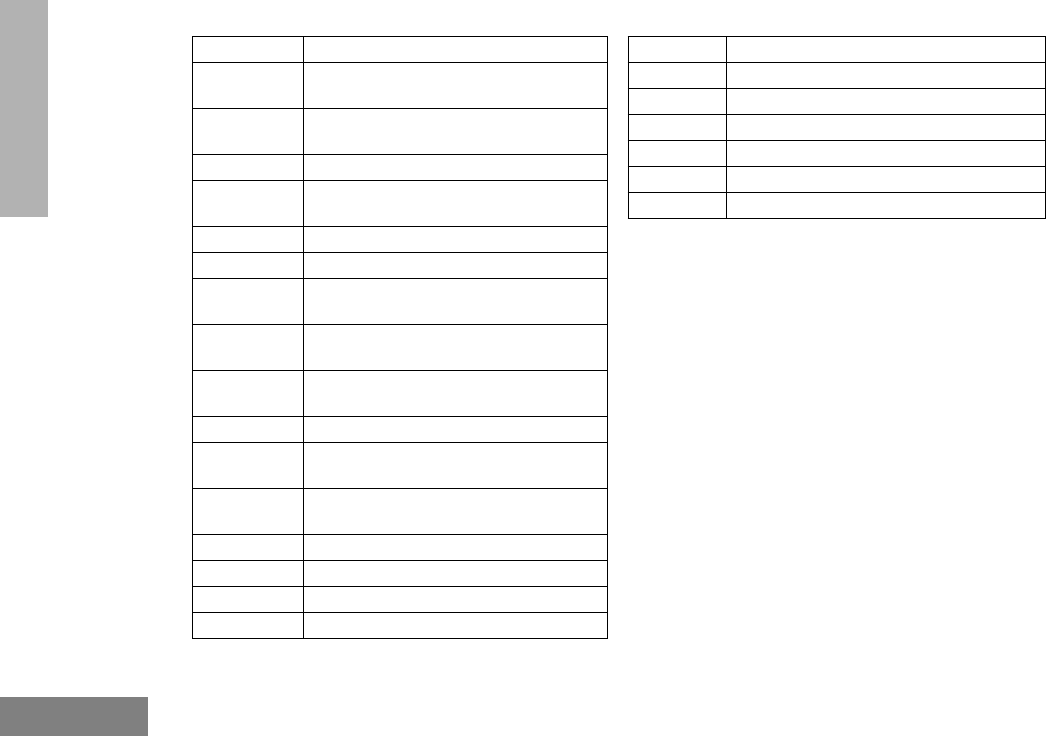
56
English
ACCESSORIES
ANTENNAS CONTROL STATION
Note: A variety of interchangeable buttons
are available for use in the P1-P4
locations on your radio (page 5). See
your dealer for further details.
HAD4006 VHF 136-144 MHz, 1/4 Wave Roof Mount
HAD4007 VHF 146-150.8 MHz, 1/4 Wave Roof
Mount
HAD4008 VHF 150.8-162 MHz, 1/4 Wave Roof
Mount
HAD4009 VHF 162-174 MHz, 1/4 Wave Roof Mount
HAD4014 VHF 146-172 MHz, 30dB Gain Roof
Mount
HAE4002 UHF 403-430 MHz, 1/4 Wave Roof Mount
HAE4003 UHF 450-470 MHz, 1/4 Wave Roof Mount
HAE4010 UHF 406-420 MHz, 3.5dB Gain Roof
Mount
HAE4011 UHF 450-470 MHz, 3.5dB Gain Roof
Mount
HAE4019 UHF 450-470 MHz, 5dB Gain Roof
Mount
HAE4004 UHF 470-512 MHz, 1/4 Wave Roof Mount
HAE4012 UHF 470-494 MHz, 3.5dB Gain Roof
Mount
HAE4013 UHF 494-512 MHz, 5dB Gain Roof
Mount
HAB9405 Lowband 29.7-36 MHz
RAB4003 Lowband 36-42 MHz
RAB4004 Lowband 42-50 MHz
09-02105F01 BNC Connector
GPN6145 Desktop Power Supply 1-25W (EMC)
HPN4002 Desktop Power Supply 1-25W
GPN6149 Desktop Power Supply 25-45W (EMC)
HPN4001 Desktop Power Supply 25-45W
RMN4030 Desktop Microphone
GLN7318 Desktop Tray without Speaker
GLN7326 Desktop Tray with Speaker
88C37_English.book Page 56 Wednesday, April 21, 1999 10:49 PM
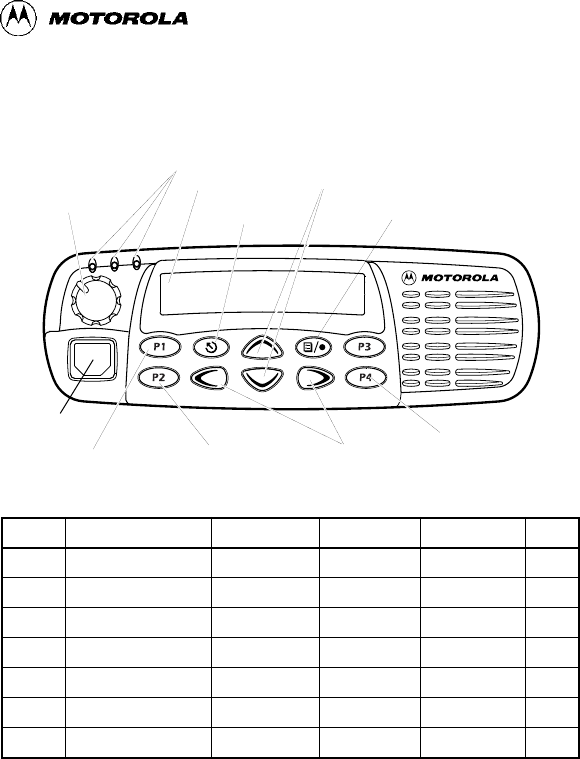
Sending a Call
1. Turn radio on and select appropriate zone and channel.
2. Press PTT, hold the microphone 1 to 2 inches (2.5 to 5 cm) from your mouth,
and speak clearly into it.
3. Release PTT to listen.
Receiving a Call
1. Turn radio on and adjust volume to the desired level.
2. Select desired channel.
3. To receive incoming call, press PTT, hold the microphone 1 to 2 inches (2.5 to
5 cm) from your mouth, and speak clearly into it.
Deleting a Nuisance Channel During Scanning
1. While radio is on a nuisance channel, hold down preprogrammed Scan button
until you hear a tone.
2. Release Scan button.
Making a Phone Call
1. Press Phone button, or select Phone from the menu.
2. If access code is not displayed, send access code if required.
3. Send phone number in one of the following ways:
¥ Press and release PTT to send last dialed number.
ÑorÑ
¥ when using keypad microphone only, press preprogrammed Speed Dial
button, followed by a keypad key (1Ð8), to access Þrst nine numbers in your
phone list. (Press PTT if buffered dial.)
ÑorÑ
¥ when using keypad microphone only, enter phone number using the key-
pad. (Press PTT if buffered dial.)
4. Press PTT, hold the microphone 1 to 2 inches (2.5 to 5 cm) from your mouth,
and speak clearly into it.
Ending a Phone Call
1. Send deaccess code if required.
2. Press preprogrammed Phone button, or press (.
Sending and Cancelling an Emergency Alert
¥ To activate Emergency Alert., press preprogrammed Emergency button.
¥ To cancel, press and hold down Emergency button.
ª Quick Reference Card
Record the functions for your radioÕs programmable buttons in the table
provided below. For further information, see pages 8 and 9 of this User Guide.
Editing
Buttons
Menu Enter/Select
Button
(Interchangeable)
Programmable
Button 2 (P2)
Menu Navigation Buttons
(Interchangeable)
Programmable
Button 4 (P4)
(Interchangeable)
Programmable
Button 3 (P3)
LCD Screen
Red/Yellow/Green
LED Indicators
(Up/Down)
Menu Exit/Escape
Button
(Interchangeable)
Programmable
Button 1 (P1)
Channel Selector/
(Left/Right)
Accessory
Connector
Knob
On/Off/Volume
Button Function Short Press Long Press Hold Down Page
88C37_English.book Page 57 Wednesday, April 21, 1999 10:49 PM
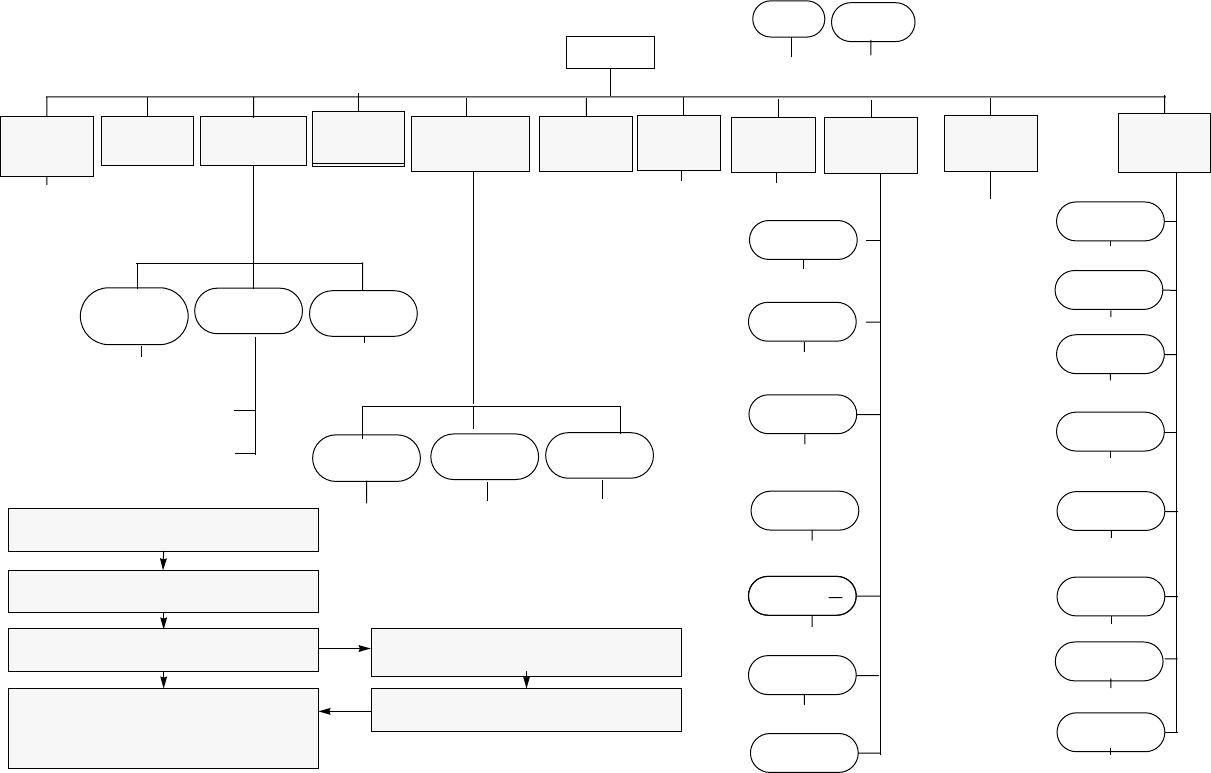
+e
+e
Power
Level
high/low/
auto
Software
Ver#
Light
Disable
on/off
Language
Select
select
Reminder
Alarm
on/off/
set time
Clock
display/
set time
Utilities
p. 43)
Option
Board
on/off
Menu Navigation
))
))
on/off
Scan List
(p. 30)
add/delete
entry
Alert Vol
Lvl
Tone
Disable
Escalert
Keypad
Tones
edit entry
on/off
+e+e +e
repeater mode/
talkarnd mode
+e +e
on/off
on/off
on/off
Companding
on/off
Call
Tone Tag
standard/alert
#1 - #7
Name
Tone Tag
) to enter Menu Mode
+ or e to scroll through the list
) to select Menu item
( to return to previous menu level
ÑorÑ
Hold down ( to exit Menu Mode
+ or e to scroll through
sub-list
) to select sub-menu item
RadioCall
List
(p. 24)
Phone
(p. 35)
Program
Lists
System
Scan
(p. 29)
Audio/
Tones
(p. 41)
Rptr/
Talkarnd
(p. 25)
Radio Call
(p. 19) Zone
(p. 16)
Menu Navigation Chart
(Refer to Menu Navigation guidelinesÑ
lower, left-hand corner of this page)
Status
select/
enter ID
Mess-
sages
select/
enter ID
All Group
Scan
edit
priority
Phone List
(p. 36)
all/delete/
edit entry/
edit codes
Call Alert
Selective
Call
Radio
Check
select/
enter ID
select/
enter ID
select/
enter ID
Message
select/
enter ID
Status
select/
enter ID
standard/alert
#1 - #7
Message
Tone/Tag
standard/alert
#1 - #7
Phone
(p. 35)
88C37_English.book Page 58 Wednesday, April 21, 1999 10:49 PM